3 Days in Venice: A Perfect Itinerary for First Timers
If you’re here planning a trip to Venice and you’ve read any of our other Italy guides, you’ll know that one of our favorite things about Italy is the regional diversity that comes from its history as a series of independent (and oftentimes adversarial) city states all vying for power and influence on the Italian peninsula.
Despite the fact that it FEELS really old in large part due to the Roman empire, the country of Italy is actually one of the youngest countries in Europe, only becoming a united, independent nation in the 1860’s.
Venice is perhaps the most unique of Italy’s city states, rising to power in the 13th Century as one of the most wealthy and powerful influences in the Mediterranean, with trade connections running as far as China and other east Asian powers.
At its height, they controlled everything from the lagoon where Venice is today, northern Italy (almost to Milan), the Croatian coast, and even Cyprus.
Then, it all began to crumble when Portugal managed to go around the Horn of Africa to establish trade with India, which undercut Venice’s monopoly on trade with Asia.
Modern Venice is a different beast. It’s often the first city that people think of when you say the word “overtourism,” and for good reason.
The infrastructure in Venice is not really built for thousands of tourists to arrive per day, and the first thing you’ll think when you get your first glimpse of the city is probably some version of “why in the world would you build a city here in the middle of a shallow lagoon?”
However, we think Venice is absolutely worth visiting for a couple of reasons.
First, and most obviously, it’s a beautiful city.
The well-preserved canals are an incredibly unique aspect of visiting Venice, and the wealth that the Venetian Republic accumulated means that the art and architecture is gorgeous.
Second, it offers a very different set of influences in its culture, food, art, and architecture (their big church is modeled after the Church of the Holy Apostles in Constantinople, which no longer exists) than places like Rome, Florence, and Milan.
Rather than skipping Venice or doing it as a day trip to check an item off the bucket list, we recommend spending three days exploring the city, which gives you plenty of time before and after the hordes arrive and depart to see a quieter side of the city.
Plus, by spending a few days in Venice, you’re contributing to the local economy with your accommodations and dining, which is a positive in our minds.
We have put all of our tips, tricks, and discoveries into this guide to help you plan an amazing trip, especially if it’s your first time.
In this guide to planning your trip to Venice, you’ll find a detailed three day itinerary, complete with things to do, see, eat, and drink, along with the important details you need to know to have a memorable trip.
You’ll also find logistics – like how to get around and some useful tips and tricks for visiting Venice – that are important for planning your trip.
We hope you enjoy this guide, that you find it helpful for planning your trip, and we help you discover something new and exciting, whether it’s your first time, or tenth.
Sound good to you? Let’s get into it.
PS: This guide is LONG. I’m not really known for being brief to begin with. As I got into writing, I realized that I have a lot to say about how to have a pleasant trip to Venice, so I just…kept writing. Grab a cup of coffee or a glass of wine, it’s a long one!
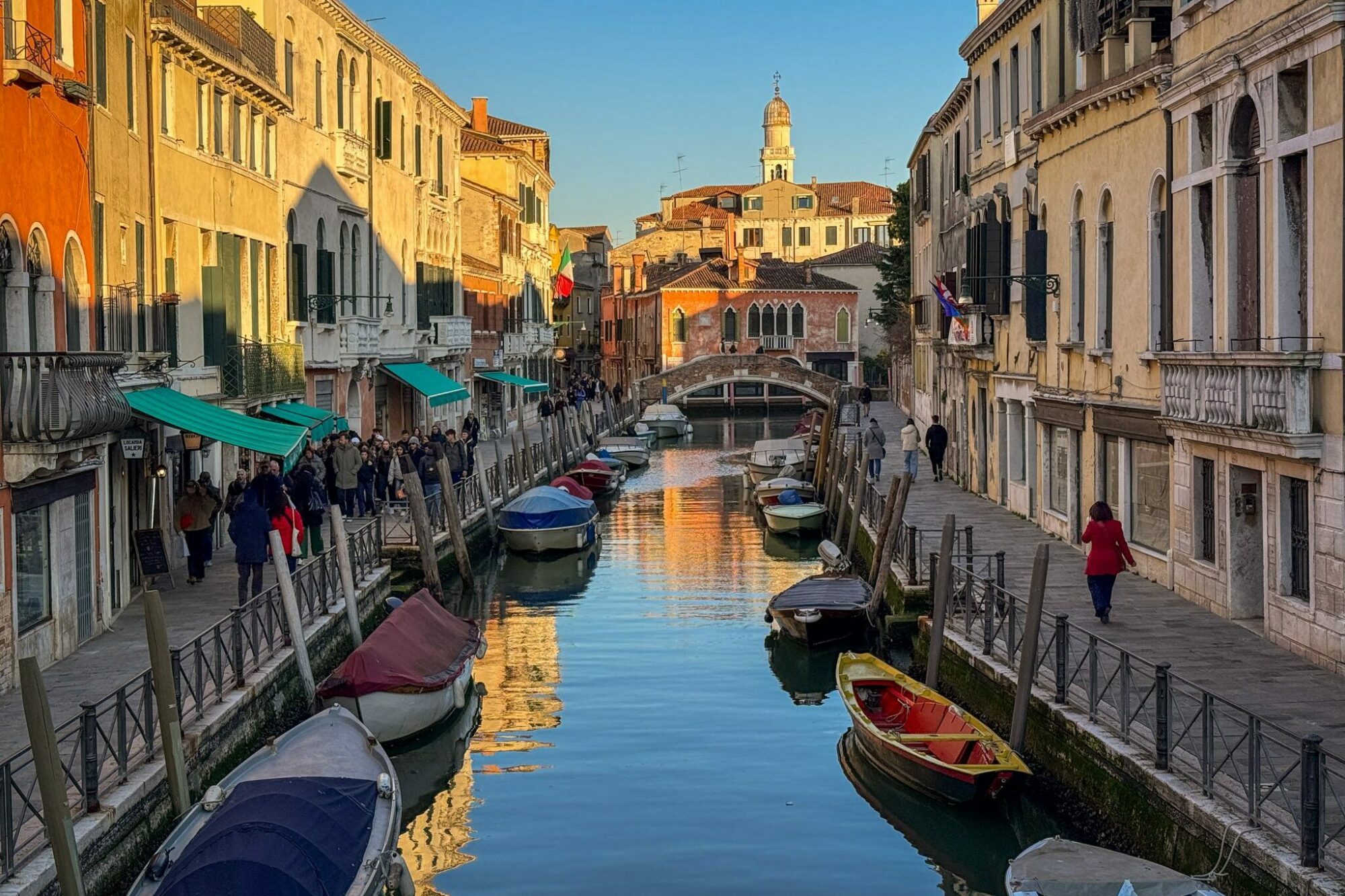
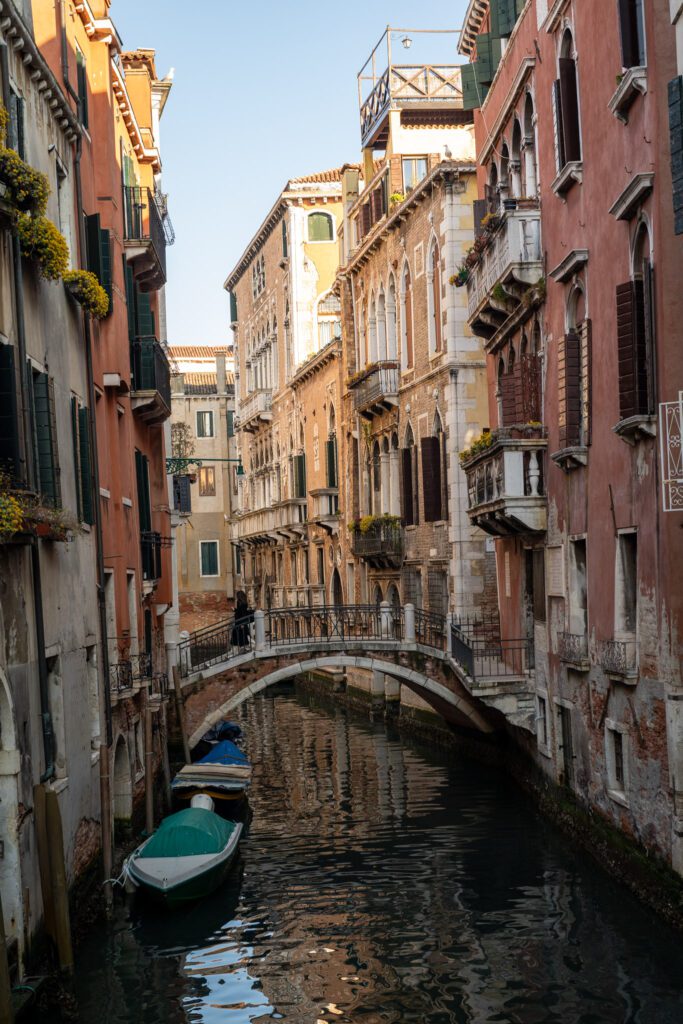
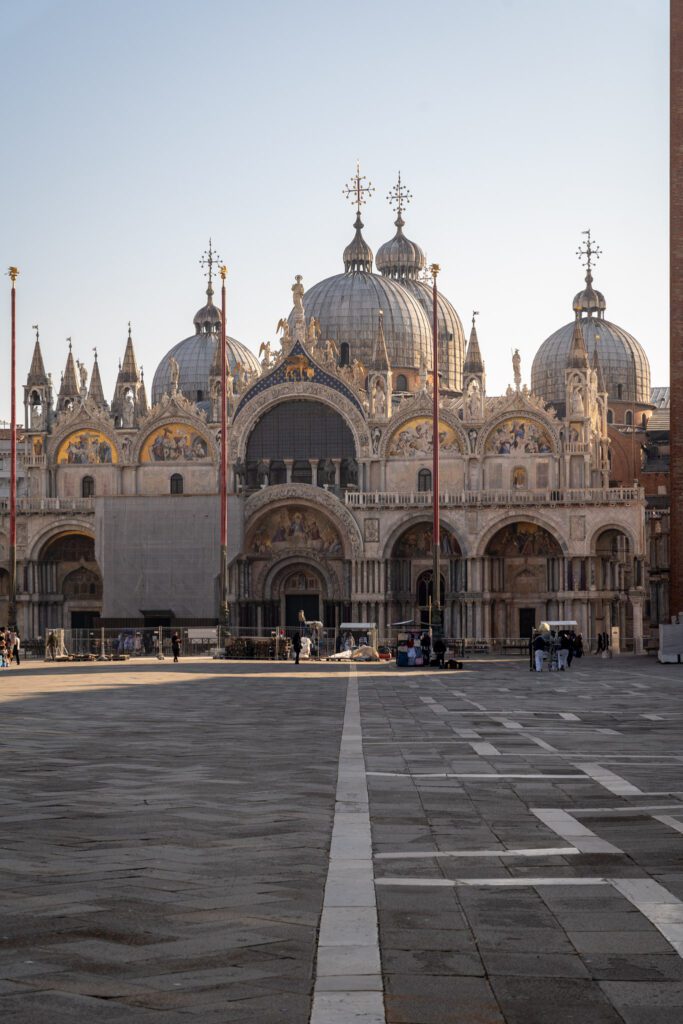
Disclaimer: Some of the links below are affiliate links, which means that if you click on one and purchase something, I make a small portion of the sale at no additional cost to you. It goes without saying that I would never recommend something I wouldn’t use or do myself.
How Many Days Do You Need in Venice?
As we already sort of covered in the introduction, we think you should spend three days in Venice.
This is one of the most unique cities in the world, and there is so much more to it than just the corridor from Rialto Bridge to St. Mark’s Square, which is where 90% of visitors spend their time.
To be transparent here, we originally had planned on writing this guide for two days and it was about 80% done when Matt had the realization that there was just too much that he wanted to include and it was getting WAY too jam-packed for two days.
Which means you’re losing out on the unplanned wandering time which turned out to be the best part of being in Venice.
Plus, the best time to be in Venice is before 9am and after 7pm, and having an extra day available positions you to maximize your time in the city early in the morning and later in the evening.
For context, Matt was just in Venice to rewrite this guide from the ground up and he spent three days exploring the city (for the third time) and felt like that was a perfect amount of time to do Venice at a reasonable pace.
With three days, you’ll be able to explore some of the history and culture associated with the Venetian Republic, take a ride on the vaporetto – Venice’s famous water buses that are also public transportation – to see the city from the canals, and enjoy the cornucopia of delightful food and drinks that lean heavily on the seafood.
You could do all that in two days, but it will be rushed and you’ll miss out on a few key experiences.
The one worthwhile thing that we think is a little too much to fit into two days is the trip out to the islands just north of the city to visit Murano or Burano.
If you have anything less than three days, we’d skip those and focus on the city itself.
If you have less than three days, we’d strongly recommend making it a priority to have at least one night in Venice because it really is a different place early in the morning and late in the evening, which is the most pleasant time to be in the city.
Where to Stay in Venice
The first thing you need to know here is that we strongly recommend staying in the city of Venice itself, rather than on the mainland (which is connected by train, but adds time and complexity to your visit).
It is absolutely going to be cheaper to stay on the mainland, but you’ll miss out on the easy access to the city in the early morning and late evening, which is (as we’ve already mentioned) the best time to be in Venice.
The second thing you should know is that we don’t really recommend staying anywhere near Piazza San Marco because it is a ZOO, and it’s where the vast majority of tourists tend to congregate.
With those two notes out of the way, let’s quickly touch on Venice’s geography.
Venice is made up of somewhere around 125 islands connected by 400+ bridges.
It’s divided into six sestieri; San Polo (the center of the city), San Marco (near Piazza San Marco), Dorsoduro (the southern end of Venice), Santa Croce (near the Train Station), Cannaregio (the northern end of the city), and Castelo (the eastern chunk of the city).
We think there are three clear winners in terms of places to stay, and they form the central spine of the city – San Polo, Dorsoduro, and Cannaregio.
I would definitely avoid staying anywhere between the Rialto Bridge and Piazza San Marco, which is the part of the city most packed with tourists AND the part of the city that has the least character (in my opinion), with lots of shops catering to tourists (either luxury shopping or kitschy shops selling magnets and postcards).
On my (Matt here) latest trip to Venice, I stayed in San Polo (at Palazzo Morosini Degli Spezieri) because it is almost the exact center of the city – which means it’s walkable to just about everything – and I would not hesitate to recommend it.
It’s a good balance between central location and being a bit quieter than places like San Marco PROVIDED you do not stay next to the Rialto Bridge.
I’d recommend choosing a place to stay in the southern half of the neighborhood, closer to Campo San Polo and the Ponte dell’Accademia, which is much quieter (and you’ll hear a lot more Italian spoken, which is always a good sign).
For more detail behind these recommendations, make sure to read our guide to where to stay in Venice, which covers our recommendations on the best places to stay for first timers (with pros and cons for each to help you make your decision).
San Polo: The Heart of Venice
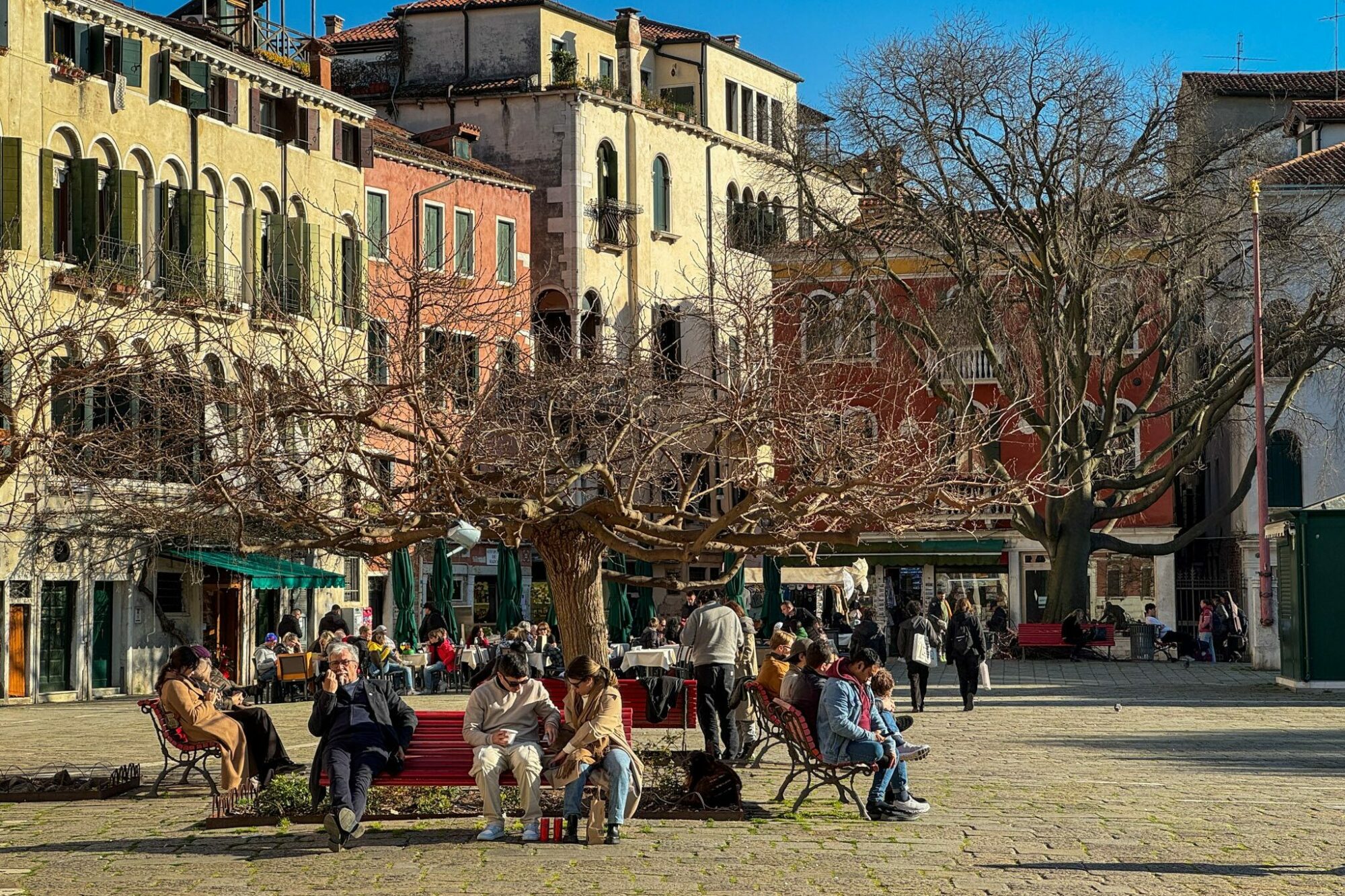
If you think about the layout of Venice’s sestieri, it’s kind of like a flower, with one neighborhood at the center, and the other five fanning out from there.
The train station sits in Santa Croce, the western edge of the city, while Piazza San Marco sits on the southeastern edge of the city in San Marco.
San Polo is the neighborhood right in the middle. The eye of the storm, if you will.
From San Polo, you can walk basically anywhere in Venice within 20 minutes or so.
But San Polo is a great neighborhood to explore in its own right.
My second favorite church (after the Basilica di San Marco) is the Frari Church (that’s the colloquial name – its full name is Basilica di Santa Maria Gloriosa dei Frari), which is an imposing brick building that soars above the canalside houses and seemingly comes out of nowhere.
Campo San Polo (here on Google Maps) is an excellent example of the big, open shared spaces that I think Italy does well, and wish we had more of here at home.
It’s full of dogs chasing balls, people sitting on the benches and basking in the sun deep in conversation, and a few lively restaurants with outdoor tables on the southern end of the square.
A few of my favorite food and drink experiences in Venice were in San Polo, too. Wine at La Bottiglia (here on Google Maps). Coffee at Caffè del Doge (here on Google Maps). Dinner at Frary’s (here on Google Maps).
Given the central location, there are a surprising number of good places to eat and drink in San Polo.
One thing I would say is that I much prefer the area of San Polo that is furthest southwest, further away from the madness that is the area near Rialto Bridge and closer to the Frari Church and Campo San Polo.
- Palazzo Morosini Degli Spezieri: This is where I stayed because I wanted an apartment with a kitchen and a little extra space to spread out and do some writing, and I would recommend it (though it’s certainly not cheap). Beautifully renovated apartments in a historic palazzo, and my room had a view of the canal from both the kitchen and bedroom! The location is great, the staff are friendly and helpful, and the shared patio is a nice refuge from bustling Venice out the front door. They have one, two, and three bedroom units (though it’s mostly one bedroom).
- Acca Hotel: If you want a nice modern hotel in a good location half a block from Campo San Polo, this is a great option. Pretty standard hotel rooms here, but they have all been recently renovated (there are some reviews from ~6 years ago where the hotel was clearly not in great shape, but recent reviews are stellar).
- Ca’ Angeli: If you’re looking for a good value in San Polo, this is where we’d look. The building is along the Grand Canal, about a five minute walk from both Rialto Bridge and Campo San Polo. They’ve restored an old residence and kept a lot of the character intact, which is cool. Rooms are pretty small, but part of the reason they’re relatively affordable (it is Venice, so costs are generally higher) is that they have a nice range of room types, from singles and standard doubles, to suites overlooking the Grand Canal.
Dorsoduro: The Coolest Neighborhood in Venice
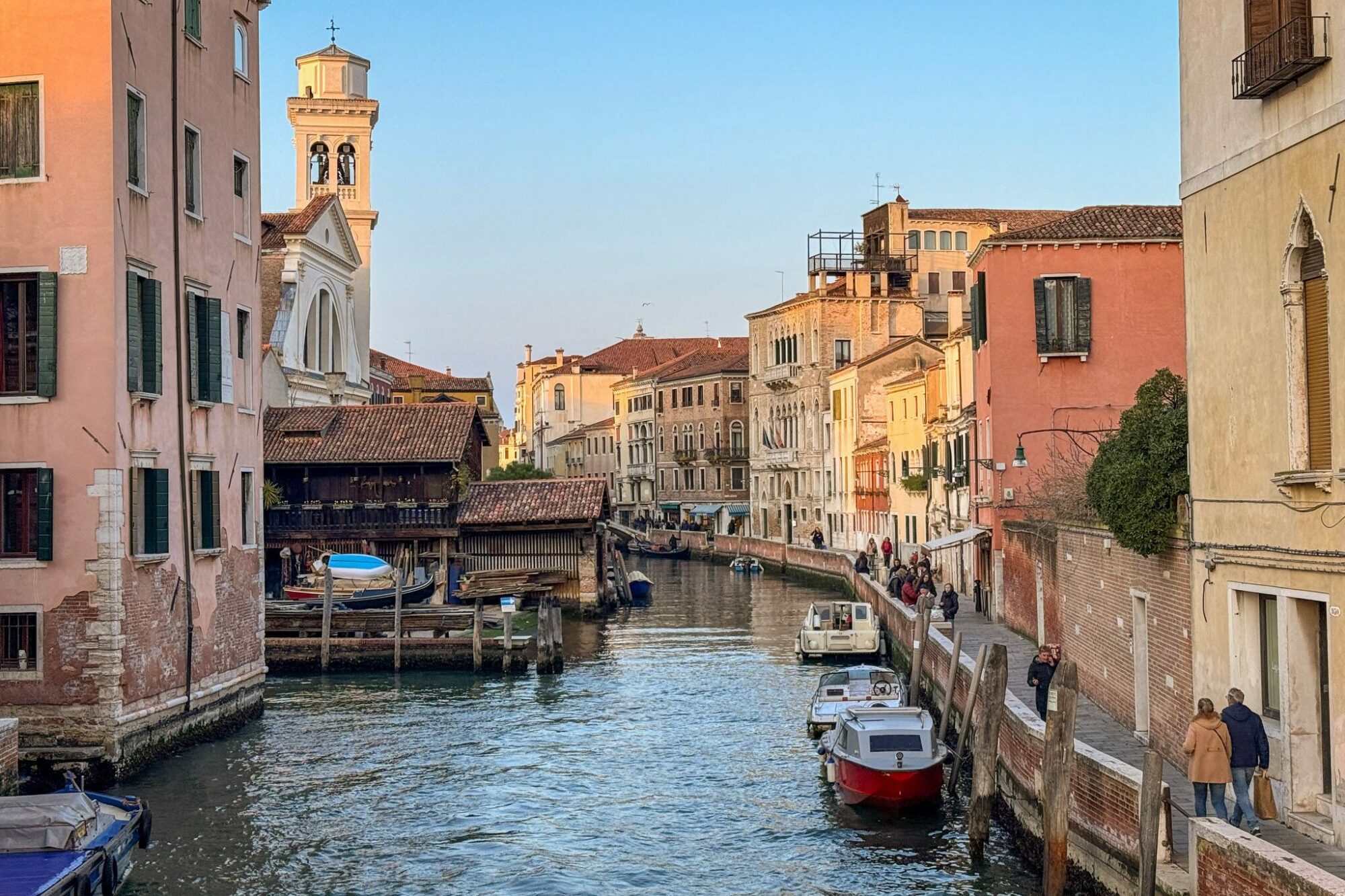
If you want to stay in what became my favorite neighborhood to hang out in and explore, stay in Dorsoduro.
While places like Cannaregio tend to lean a little bit older, walking around Dorsoduro feels quite a bit younger thanks in large part to the university.
It’s a neighborhood where people actually live – a rarity in modern day Venice – and is centered around the university, which gives it a nice youthful vibe.
However, putting aside the younger vibe, there are also countless gems to be found in Dorsoduro, from the art museums (both the Gallerie dell’Accademia and Peggy Guggenheim collection are here) to the cicchetti at bacari (the stretch along Fondamente Nani is one of the best in the city – here on Google Maps) and the lively Campo San Barnaba.
Plus, the canalside promenade along the southern end of the neighborhood to the towering cupola of the Basilica Santa Maria della Salute, where you’ll find frescoes by Titian and Tintoretto along with a great view from the dome, is a must-do.
This basilica was erected as a “thank you” for Venice surviving a plague in the 17th Century (entrance is free, but you have to pay to go up to the dome and into the sacristy).
As you might imagine, the characteristics I laid about above that explain why I’m enamored with Dorsoduro also mean that there are fewer places to stay here. Though there are a few gems.
Cà Santo Spirito: A more value-oriented option on a quiet street near La Salute (the basilica), this is a great little B&B that puts you in a nice location for exploring the rest of Venice.
Rooms are comfortable, nothing extravagant, and it’s a true bed and breakfast, meaning that breakfast is included in the room rate.
Two room types here; the double room that is a classic hotel-style room, and the bigger suite that has a seating area and sofa bed.
Palazzo Veneziano: A beautiful modern hotel on the southern end of the neighborhood along the water, this is a place to stay if you’re hoping for a touch of luxury on your trip to Venice.
If you want a room with a canal view, they have a bunch of options (though they are a little extra). Rooms are modern, with hardwood floors in the bedroom and marble textures in the bathrooms.
Nice, but somewhat expensive, breakfast buffet (though we usually prefer to get coffee and cornetti out and about).
3 Days in Venice: A Complete Itinerary for First Timers
And now, into the itinerary we go.
Generally speaking, there are three things we think you should focus on in Venice; the sights at Piazza San Marco (mostly the Doge’s Palace and Basilica di San Marco, which give you a nice foundation for understanding Venice), seeing the city from the water, and exploring Venice’s food scene, which revolves around the bounty of the sea that is so connected to Venice’s rich (literally and figuratively) past.
We also think that you should make it a priority to see Piazza San Marco twice – once before the crowds show up, and once to visit the basilica and Doge’s Palace.
Yes, it means an early wake up call, but walking the canals and enjoying the piazza before 8am was the highlight of my latest trip.
Going into the trip (and in an earlier version of this guide), my recommendation was to get in, see the sights, and leave as soon as possible because my previous experiences with Piazza San Marco were hot, crowded, and somewhat miserable.
However, after having that early morning experience on this latest trip, I think it’s an important piece of visiting the city.
The itinerary below takes those perspectives into account and puts the two together.
Here is what the itinerary looks like written out:
- Day 1: An Introduction to Venice – Walking Tour, Doge’s Palace, Basilica Di San Marco, and Venice from the water
- Day 2: Early Morning at Piazza San Marco, San Polo, and a food tour
- Day 3: A Trip to the Islands and Cannaregio
Keep in mind that we are assuming you have three full days. You’ll have to massage and change things to fit your specific arrival and departure times.
Day 1: An Introduction to Venice
Use your first day to get a geographical, historical and cultural overview of the city to use as a foundation for your next day (when you’ll dive a little deeper).
Start with a walking tour, have lunch, and then tackle the sights at Piazza San Marco and take a nice boat ride to see the city from the water.
A Guided Walking Tour of Venice
Walking tours are our favorite way to get oriented in a new city for a few reasons.
First, you get a crash course in history and culture, which is a valuable baseline that will make the rest of your trip more enjoyable.
Second, you get to spend a few hours with a local who will give you all sorts of tips about what to eat, drink (and see), and specifically where to find the best version of said things.
Last, but not least you’ll discover places that you definitely would never have found on your own.
We always do a walking tour on our first day in a city, and Venice was (supposed to be) no different.
I chose this walking tour but, unfortunately, they cancelled on the morning of the tour and the timing didn’t work for a different day.
So while I can’t speak to how the tour actually is, I can tell you that I liked the concept enough to book it for myself.
It’s also worth noting that I did a tour covering the Jewish history of Venice with Lucia (this one), who also has an introductory walking tour that I would recommend mostly because Lucia, a Venetian, is a great storyteller and full of great recommendations that will inform the rest of your trip.
Either option has a morning tour, which will take around two hours and put you in position for lunch.
We don’t have specific lunch recommendations (for the reasons we covered above around gluten), but we’d make sure to stay outside of San Marco when looking for a place to grab a bite to eat.
Piazza San Marco
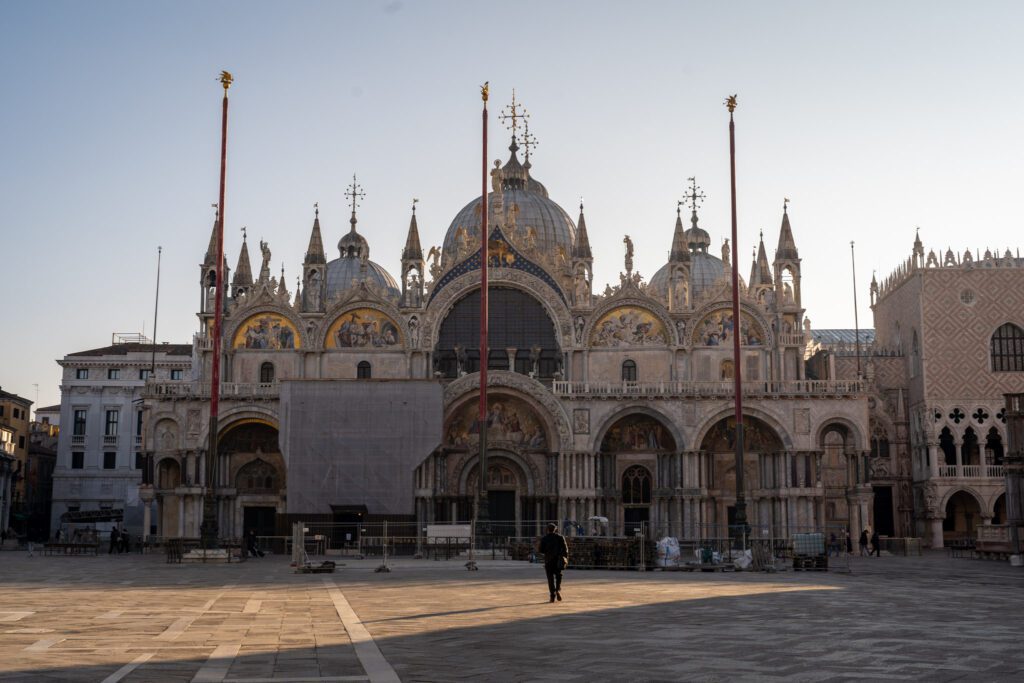
Piazza San Marco is beautiful, and we’ll have you return here early on your second morning to see it at its best, before all the crowds arrive.
The piazza forms a giant L, with a path leading to the basilica from the water (where you’ll see two big columns topped with the lion of Saint Mark and the figure of Saint Bartholmew standing on top of a dragon) and another path from the far end of the piazza to the basilica.
This piazza was the political center of Venice during the peak of the Republic of Venice, and features the Doge’s Palace (where the government operated and the Doge lived) and the Basilica di San Marco (which was, essentially, the state church).
There are a mix of architectural styles here as many of the buildings were either built or renovated across a period of several hundred years (the building at the far end of piazza across from the basilica was built by Napoleon when he invaded and conquered Venice in the early 19th Century).
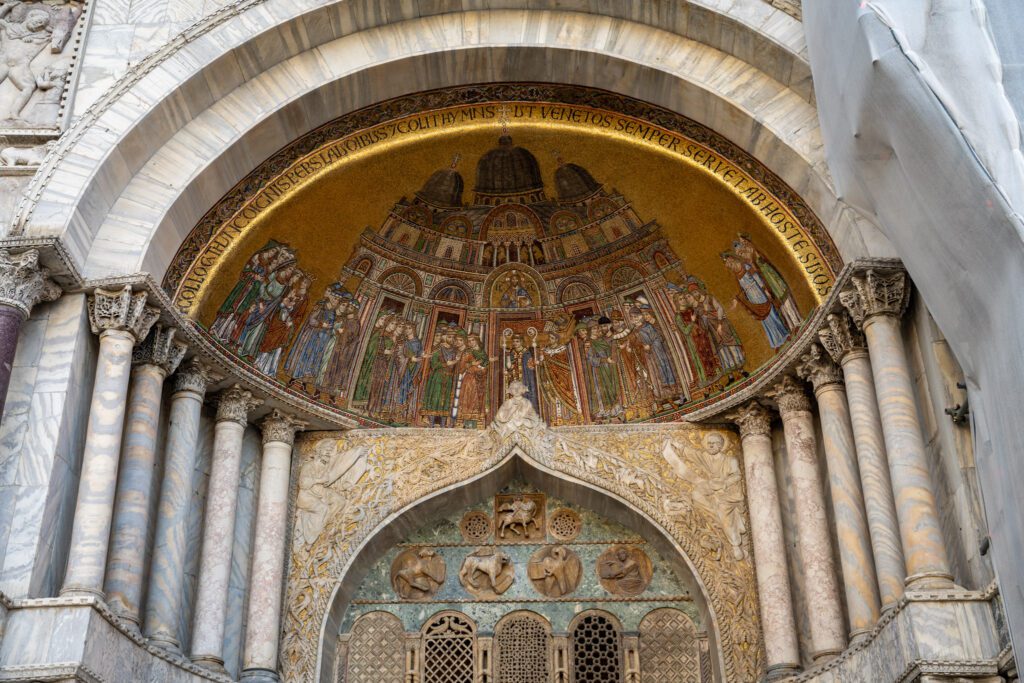
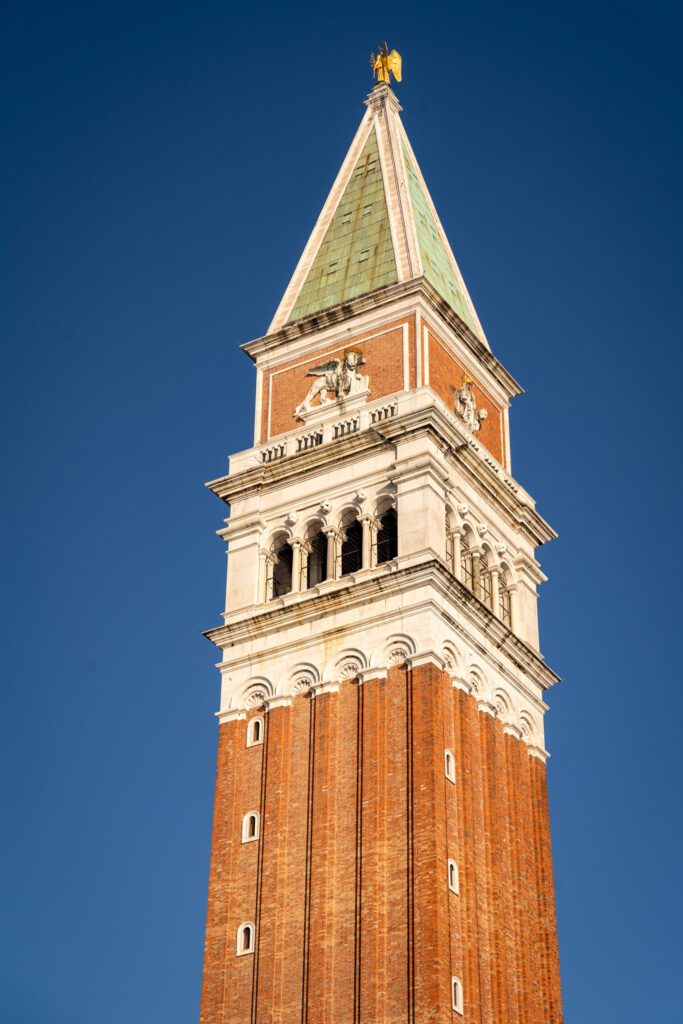
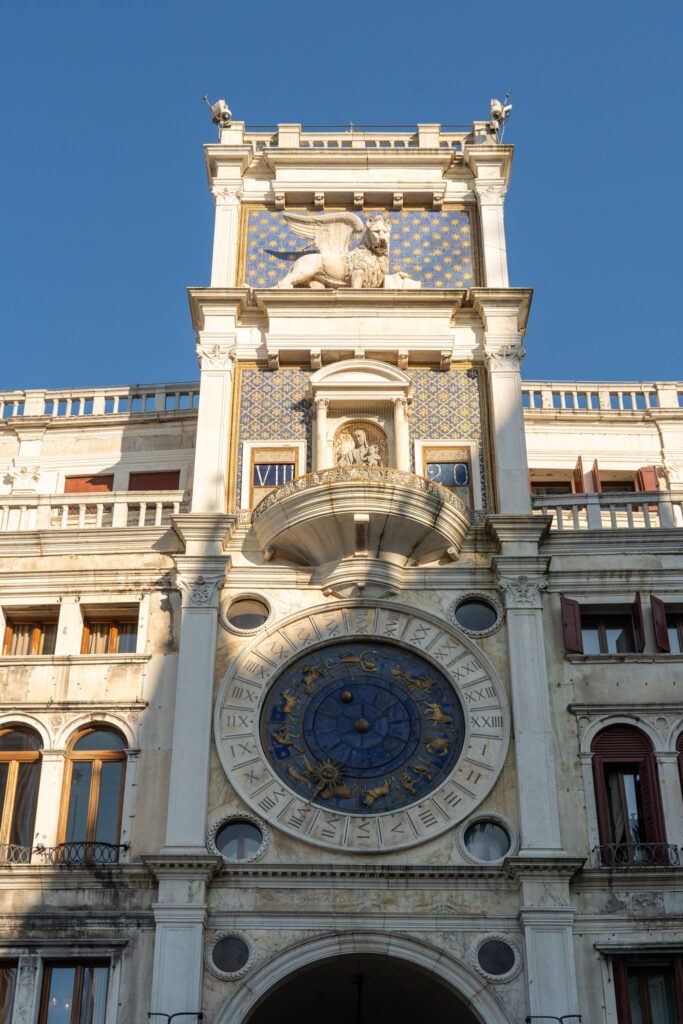
Since you’re returning early tomorrow, when it will undoubtedly be less crowded and more pleasant, we’d save most of your exploring for that time.
Instead, turn your attention to the two main attractions on the piazza; the Doge’s Palace and the Basilica di San Marco.
Usually, we try to avoid doing multiple big attractions on the same day, but in this case we think sandwiching them together is probably the right move.
If you don’t have the time, patience, energy, or budget to do both, we think it comes down to your personal interests.
We’d personally choose the basilica (which is an odd choice for us, but it’s that impressive), but the Doge’s Palace is a more interesting visit from a historical and political point of view.
St. Mark’s Basilica (The Basilica di San Marco)
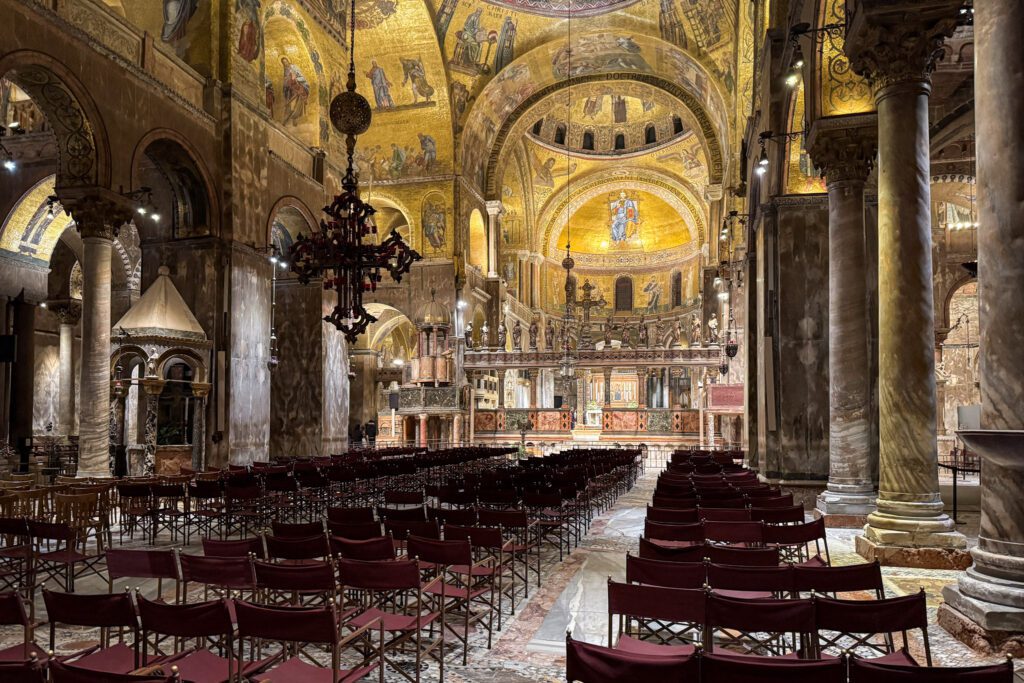
Look, I’m not a huge “see every church” person because huge, opulent churches make me a little uncomfortable (could we have ended world hunger with the gold in St. Peter’s Basilica and the Vatican? Almost certainly yes).
However, if you divorce the religious and political aspects from the architecture and design, I can get on board.
And I think the Basilica di San Marco has jumped to the top of the most impressive churches I’ve ever experienced, right up there with the Sagrada Famila in Barcelona (which is also a masterpiece in very different ways).
This basilica is magnificent, and I’m going to spoil it a bit because I want to talk about one specific aspect that left my jaw on the floor as I was wandering around the basilica.
Before we get to that, let’s step back and talk briefly about the history of this basilica and its role in Venice’s rise to power.
At one point Venice was a piece of the Byzantine Empire (as part of the territory of Ravenna), but over the course of several hundred years, they were able to build their naval power and supremacy over the Adriatic and, eventually, participate in the Crusades that culminated in the sacking of Constantinople in 1204.
Which is where the Venetians got a bunch of the adornments for the Basilica di San Marco, including the four horses over the front doors.
Once they gained their independence, the Venetians wanted to put their stamp on the city, and began to make changes.
The biggest thing they wanted to do was establish their independence through the consecration of a church, but there was one big problem; to do that, you needed to have an important religious relic, and they did not have one.
So, they stole one and manufactured a story about why it wasn’t sacrilegious (you’ll see why that was important in a second).
The story of this basilica – and the establishment of Venice as a major player on the Italian peninsula – is, quite frankly, hilarious to me. It’s every bit as salacious and worthy of an HBO show as the history of the Medici in Florence.
Though, in Venice’s case, it could just as easily be a slapstick comedy rather than a drama.
Here’s the legend as it has been passed down through generations. The Venetians identified Saint Mark as the one they wanted, and they knew his body was in Alexandria (in Egypt), which was under Muslim rule at the time.
So they sent a team to steal the remains of Saint Mark from Alexandria and smuggle them back to Venice.
Which they did by putting them in a wooden box and covering them with pork, rendering the Muslim guards unable to check if there was anything hiding under the meat.
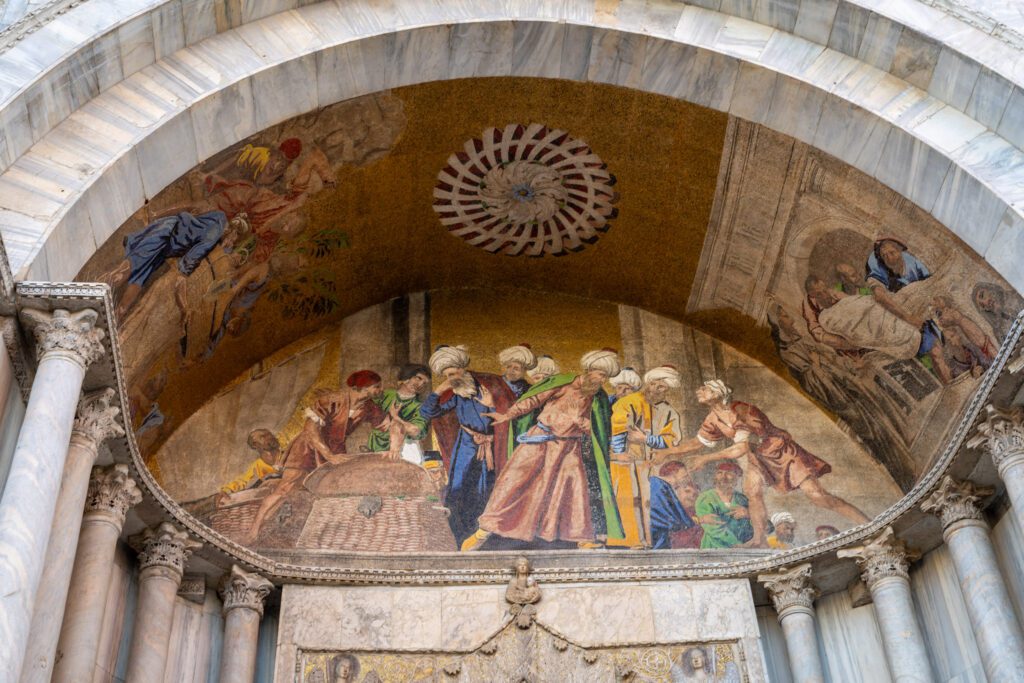
Gross, and definitely not allowed by the bible if we’re being pedantic.
They, uh, crafted a story (some would say out of thin air) about how Saint Mark was predestined to end up in Venice (or in the province that Venice was a part of), and voila! They had their religious relic.
A smaller basilica was built on the spot where it stands today, though it has since burnt down and been renovated several times.
I find that origin story, frankly, hilarious, and am unsure whether or not to believe the legend because it’s so absurd that it seems impossible that it’s completely made up.
There are two interesting aspects to this basilica that are notable (and then we’ll get to the jaw-dropping part).
First, while the exterior today is this beautiful marble, the structure is actually built out of bricks, which you can see in places from both the inside and the outside.
Because of that, the structure itself was built relatively quickly (31 years or so), though the time it took to decorate the interior and exterior was closer to 600 years, which is why it’s a mish-mash of different styles.
Second, the church is a copy of the Church of the Holy Apostles in Constantinople, which no longer exists after it was destroyed centuries ago.
It is laid out like a Greek cross, and gives archaeologists a starting point for understanding what that church looked like in the past.
Now, the piece that made my jaw drop is the incredible mosaics that adorn the entire ceiling (and floor) of the church, including the three domes that tell important biblical stories through visuals, which very much nods to Venice’s Byzantine heritage.
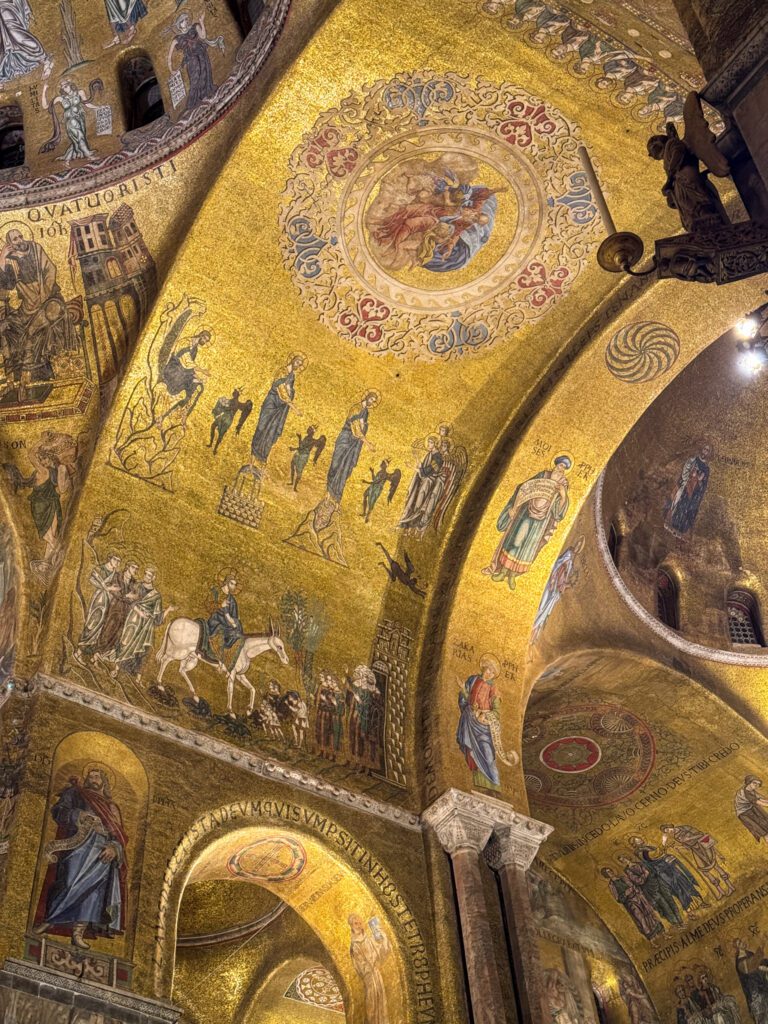
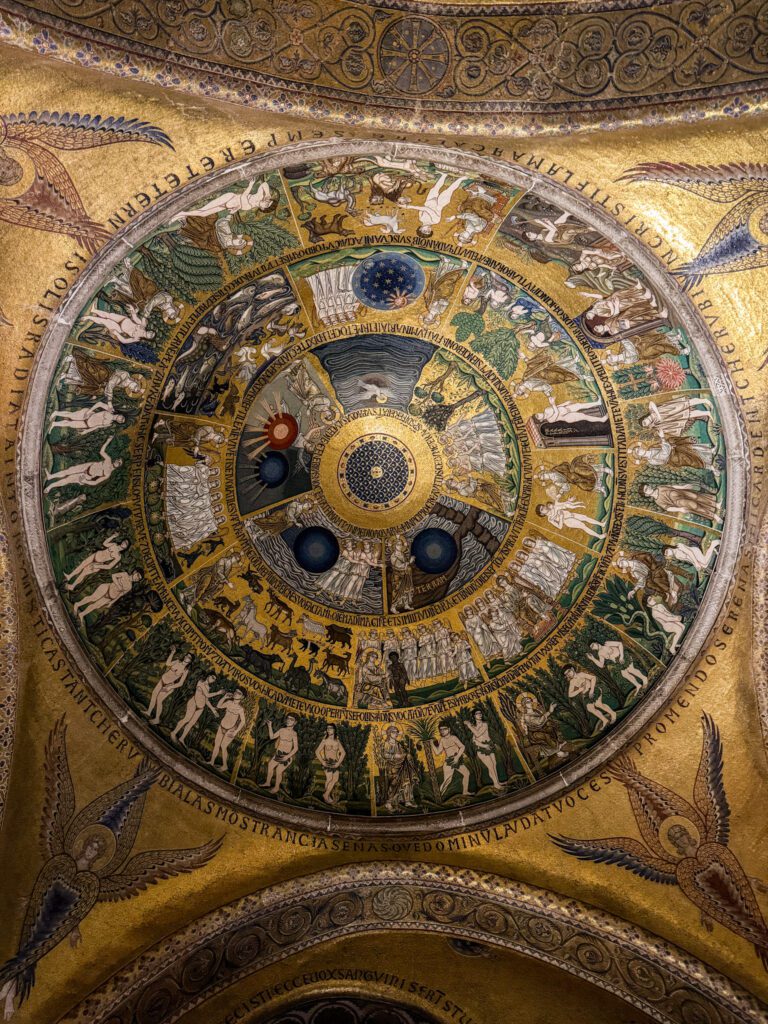
The mosaics are made up of tiny individual tiles that are crafted in a way that basically puts the color in between panes of glass so that it doesn’t fade as much over time as, say, a painting.
It’s mind blowing to consider that there was a small team basically standing on scaffolding individually placing each tile to form the incredible golden mosaics that you see today, and it’s pretty obvious why it ended up taking 600 years to decorate.
The influence of eastern powers like the Byzantine empire is a unique aspect of Venice’s heritage that other parts of Italy don’t necessarily share because they weren’t as immersed in trade with that part of the world, and there is perhaps no better place to see that influence come to life than this basilica.
Let’s talk about how to see this masterpiece.
Visiting the Basilica on a Guided Tour
As I already mentioned, I did this after hours guided tour of the Doge’s Palace and Basilica di San Marco, and it was a completely different experience than I’ve ever had visiting those places on my previous two trips.
We were literally one of two or three groups inside each place, which is a far cry from the hundreds (maybe thousands?) of people who are inside at peak times.
It’s also worth noting that I never would have been able to understand, and therefore, write the things I did above without my guide, Romi, who explained the history and design and architectural elements in exhaustive detail (not to be confused with exhausting detail).
They also have a separate after hours tour specifically for the basilica, which splits the tour I did in half.
If I had to choose one site to do a guided tour of, it’s the Basilica because I loved having the guide explain the layout and architecture and help decipher the iconography depicted in the incredible mosaics (the audio guide will do well enough for the Doge’s Palace, I’d say, if you only have time or budget for one tour).
Visiting Independently
Unlike, say, St. Peter’s Basilica in Rome, you do need to pay to enter the Basilica di San Marco now.
It costs €3 to enter the basilica, and there are two ways to get tickets: booking online in advance, or waiting in the (usually long) ticket lines on the day of.
As one of the two most popular sights in Venice, it’s definitely worth booking in advance through the Basilica’s official ticket office to avoid the long lines at the ticket office on the day of (an easy way to save an hour or two of your precious vacation time).
However, it is worth noting that pre-booking your tickets does cost an extra €3, bringing the total cost to €6 per person.
Similar to the Duomo in Florence, there are several pieces of the complex that you can choose from when you’re planning your visit.
They are the Basilica itself, the Pala d’Oro, the Loggia di Cavalli (the Horse Lodge, which is also the Museum), and the Campanile (the bell tower).
The site offers a variety of combinations of the above aspects, but we’d say there are only two pieces to focus on; the basilica and the Loggia di Cavalli OR the bell tower, which has some nice views out over St. Mark’s Square and the Venetian Lagoon.
I (Matt here) did an after hours guided tour of the basilica (highly recommended) that included the Pala d’Oro and, while it was kind of cool to see all that gold work up close, I don’t think it’s worth it for most people.
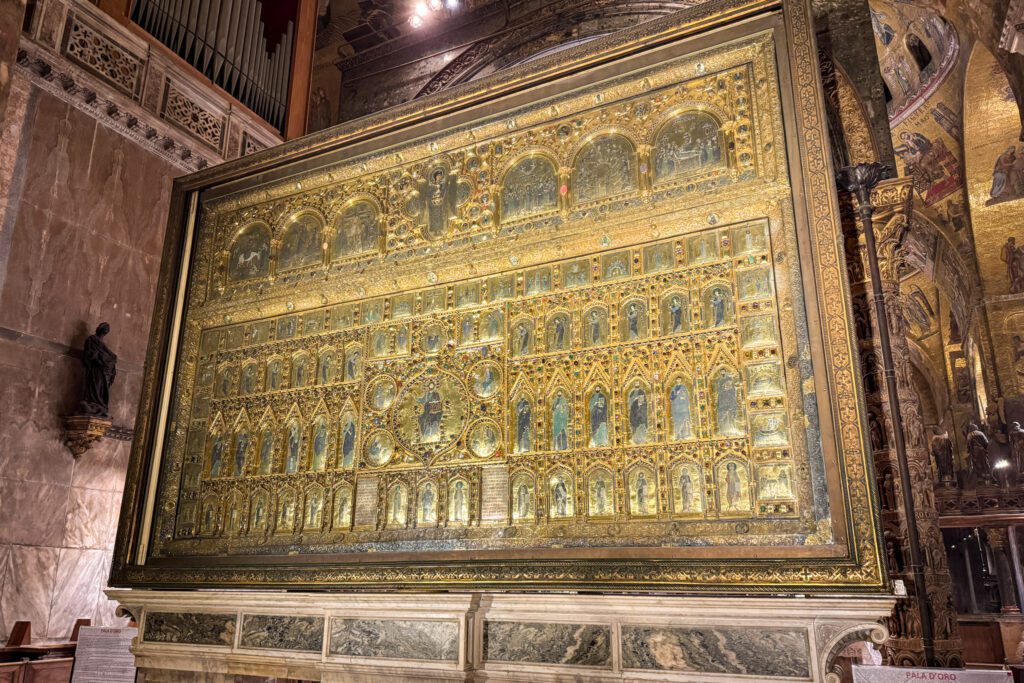
As for the bell tower, it’s a great view out over the city and the lagoon, but I don’t know if it’s really worth the €12 IF you’ve already seen the view of Piazza San Marco from the Loggia di Cavalli (which is the terrace of the basilica where you’ll find the original versions of the horses that sit above the doors of the basilica).
And if you have limited time, we’d just focus on the Basilica and Loggia di Cavalli and spend the rest of your time elsewhere (ideally far away from Piazza San Marco, which is the most crowded part of Venice).
When you look at the official ticketing site, you’ll notice that you have a bunch of choices in terms of combinations of the various pieces of the complex.
If you’re taking our advice and skipping the Pala d’Oro and seeing the Basilica and the Loggia di Cavalli, you’ll want the ticket called “Basilica S.Marco + Museum 15€” (which is a little confusing).
There’s also an option that includes the Pala d’Oro, which is called “Basilica S.Marco + Pala d’Oro + Museum Loggia Cavalli 20€” which is the ticket you’d book if you want to see the Pala d’Oro too.
You’ll choose an entry time, which means you’re not going to be as flexible, but you also won’t have to wait in the LONG lines at the ticket offices on the day of your visit.
One other note here – I have used Rick Steves’ free audio tours as a substitute for paying extra for an audio guide or a guided tour, and generally think they’re pretty good (especially considering the fact that they’re free).
He has one for the basilica, and the easiest way to access it is to download his app (called Rick Steves Audio Europe) and download the guides you want in advance, that way you can access them if you don’t have internet access.
The Doge’s Palace (Palazzo Ducale)
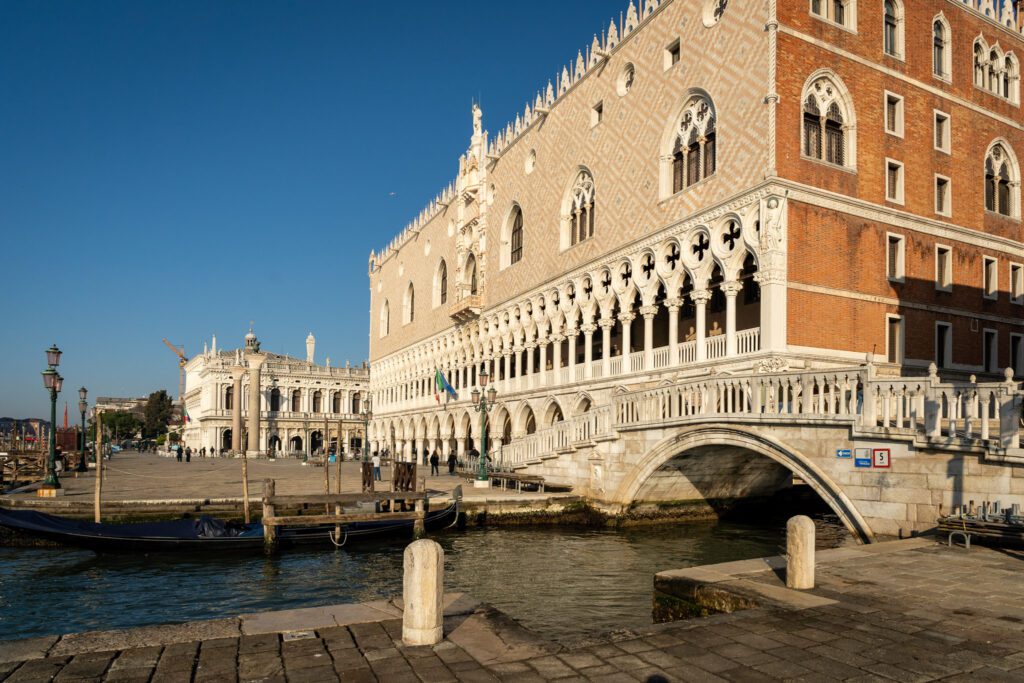
The Doge’s Palace is an excellent place to get an overview of the political forces that operated in the times of the Venetian Republic, when Venice was one of the most influential powers in Europe (particularly in the Adriatic and eastern Mediterranean).
What is interesting and unique is the political aspects of the Venetian Republic. And the Doge’s Palace is the proverbial “room where it happens” of that realm.
The building is beautiful, and the rooms in which the political machinations of the republic played out are adorned with art by the Venetian greats, like Tintoretto and Veronese, depicting key events (both real and figurative) in Venice’s history and rise to power.
There are several aspects to the Doge’s Palace that you’ll want to see; the state rooms (there are several, but don’t miss the incredible and massive Chamber of the Great Council), the armory, and the prison.
The entire interior has a lot of beautiful art with religious themes and ridiculous over-the-top gold accents, which is obviously beautiful, but is not particularly unique.
The Chamber of the Grand Council alone rivals the interior of St. Mark’s Basilica in a way, with its storytelling frescoes, high ceilings, and sequential portraits of all of the doges.
The first thing to know about the Doge’s Palace is that it’s sort of like the White House and Congress combined (if you’re American). It’s part residence for the Doge (who is for all intents and purposes something like a duke or mayor) and part government offices.
There’s also a prison aspect, with the original building serving as a jail for centuries before they outgrew it and built a new jail in the building adjacent to the palace to the east – the one that is connected via the Bridge of Sighs.
The second thing to keep in mind is that it has changed significantly over the years.
That’s partially due to expansion with the needs of Venice and its growing empire necessitating larger buildings, partially due to the fact that it has burnt down and been rebuilt several times over its history, getting grander and more opulent with each subsequent effort to rebuild.
The interior is incredibly ornate, especially in the Grand Council chambers, with dark wood, plenty of gold, and the trademark colorful frescoes that you’ll find all over Venice (the Venetian painters LOVE their bright colors and textured fabrics) painted by legends like Tintoretto and Titian.
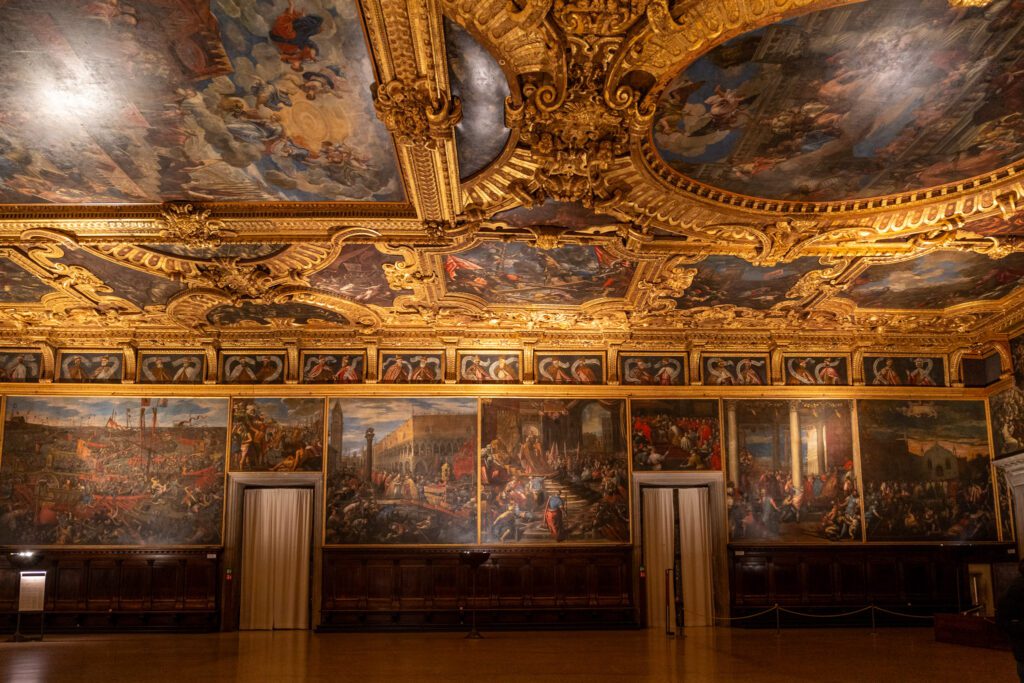
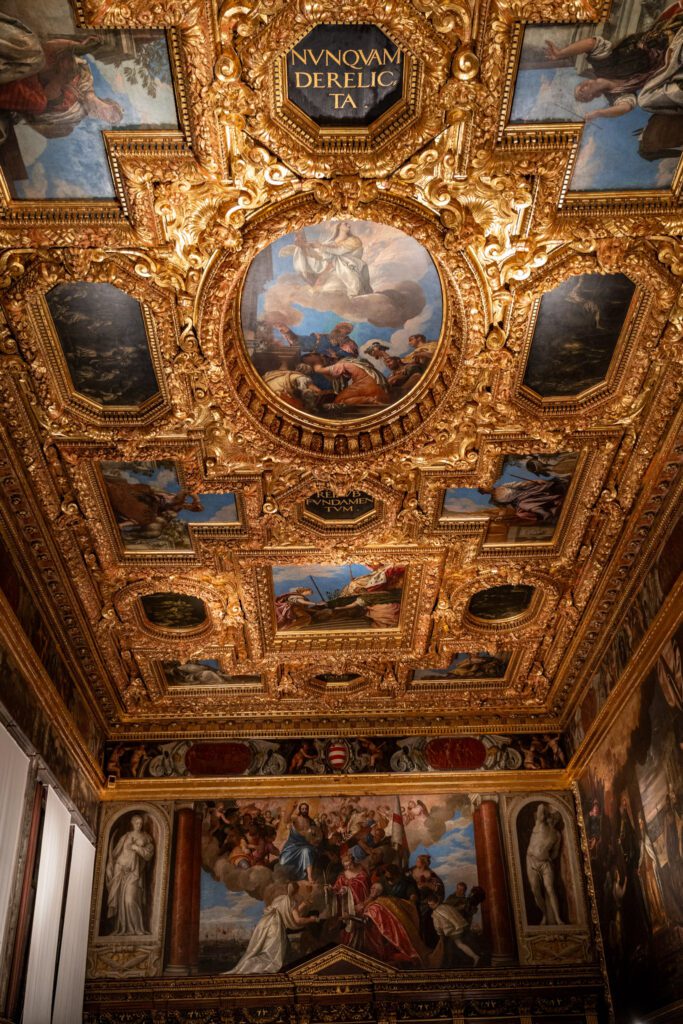
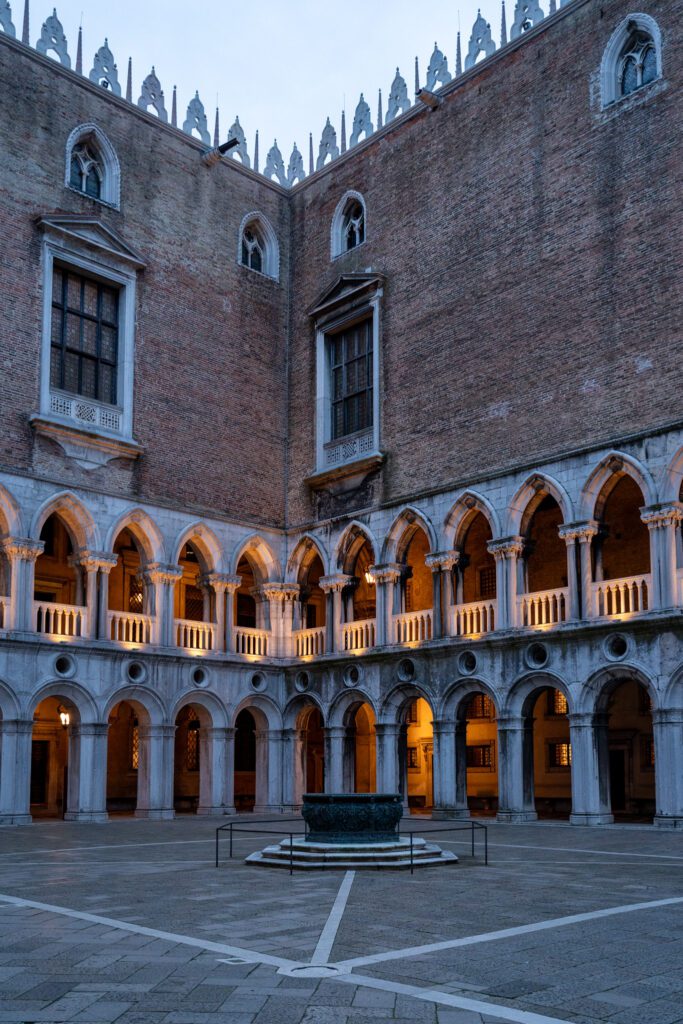
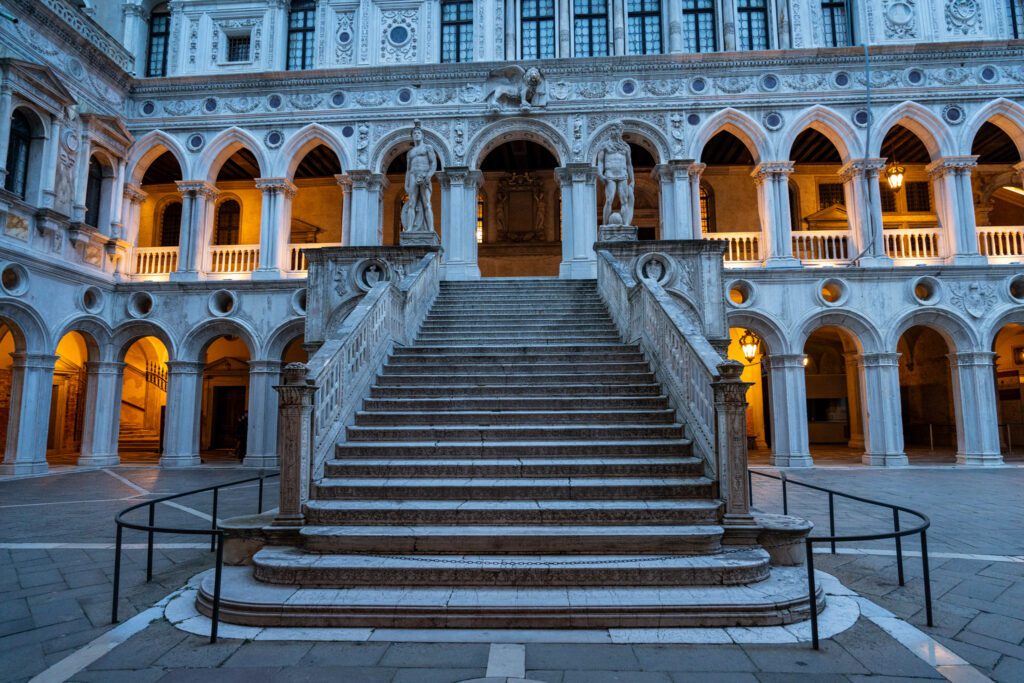
Visiting Independently
If you want to visit the Doge’s Palace on your own, you’re definitely going to want to buy tickets in advance.
Especially because the ticket price is €5 cheaper if you book more than a month in advance (€25 if you buy more than 30 days in advance, €30 if you buy within 30 days).
The official website for the Palazzo Ducale is here, and you can buy tickets directly through them.
The other thing to know is that the public opening hours on Friday and Saturday are extended to 11pm between May 1st and the end of September (basically, peak season) and it is generally much less crowded in the evening hours.
If you’re looking for a way to see the palace without all the crowds you’ll encounter during the day, that’s a good option.
As I was planning my own trip, I also realized that they have some nice resources on that site (specifically on this page – the downloads at the bottom) with good history and context that would be worth looking at before you visit.
Worth noting that your ticket is good for entry to the other museums on Piazza San Marco – the Museo Correr, Museo Archeologico Nazionale, and Monumental Rooms of the Biblioteca Nazionale Marciana – over the course of three days.
There are some additional experiences that you can book through the official website that are worth considering, though we’d really only recommend one of them.
The extra that we’d recommend is the “Secret Itineraries” tour, which includes a guided tour that covers the history and governmental institutions of the Venetian Republic.
It’s just a few Euros more than the entry ticket, and is a great option if you want to gain more insight into Venice’s history and culture without paying the premium for a guided tour through a private company.
Seeing Venice from the Water
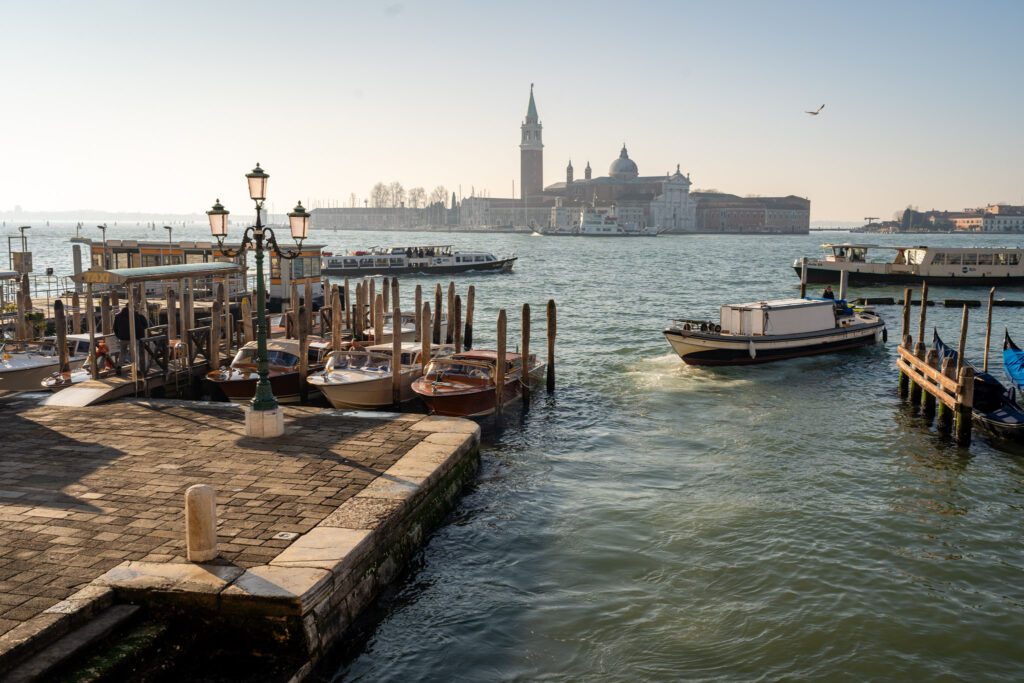
After an excellent canal cruise in Amsterdam, another European city that is built on the power of water with its numerous canals, I think that seeing the city from the water is an essential piece of any itinerary for Venice because it offers a completely different perspective.
However, I’m hesitant to recommend hopping on one of the innumerable tourist gondolas that you’ll find all over the city, with their “drivers” in striped shirts and berets because I don’t think it offers a whole lot of insight into the city AND your experience is going to vary wildly based on the gondolier you get and where you pick up the boat.
However, if that’s something that’s on your bucket list, you’ll find some thoughts in the section below on how to make the most of it (and how to organize it).
I do have two alternate options for you when it comes to seeing the city from the water, one of which uses the vaporetto and one of which puts you on a smaller boat with other travelers and a local guide.
Option 1: Using the Vaporetto
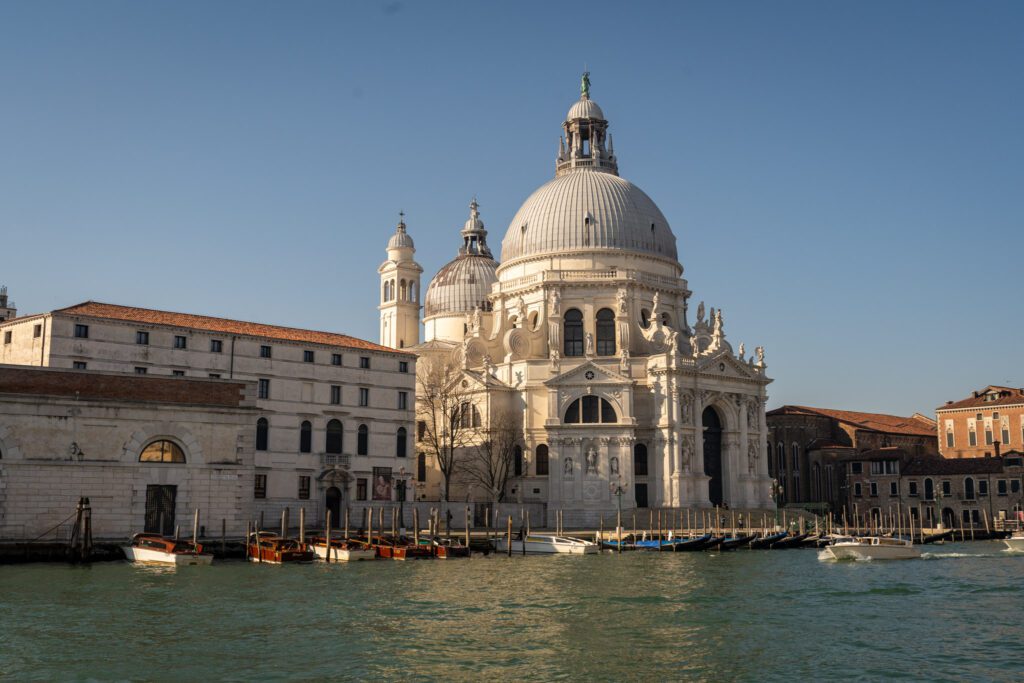
As you might imagine, this is the more affordable, self-guided option between the two because you’re using the public water buses to essentially circumnavigate the city.
To maximize your time and money, we’d walk to one end of the line, take the vaporetto all the way to the end of the line, and then walk back from there.
If you want to see more, we have an idea below on how to combine two lines to form a nice loop.
Regardless of whether or not you end up using the vaporetto in this particular way, you’ll probably ride it at least once during your time in Venice.
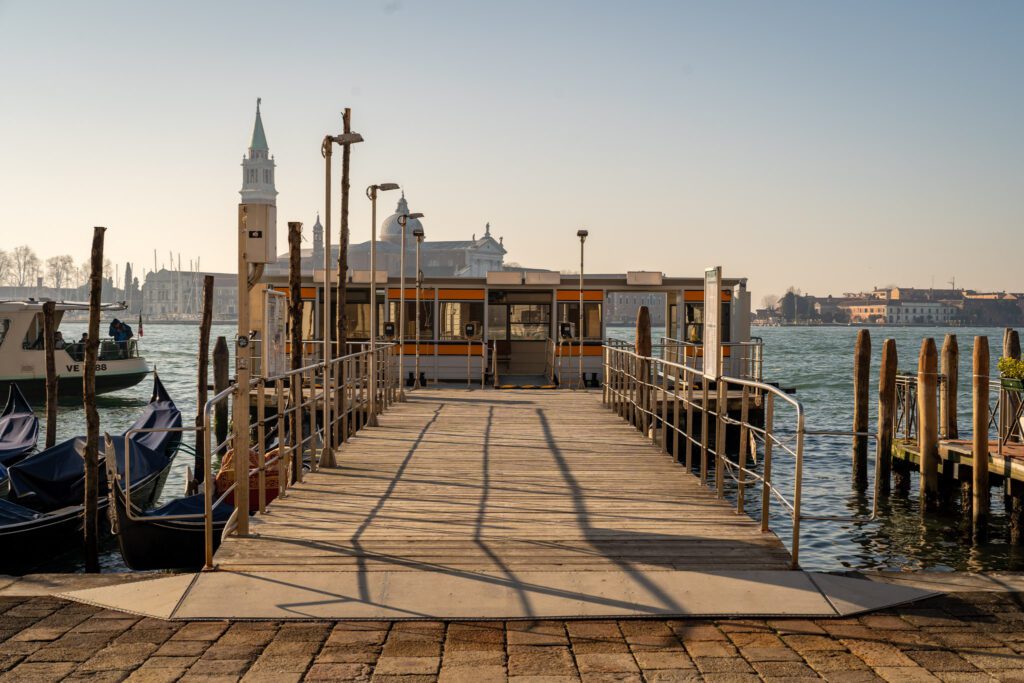
It’s the only form of public transportation in the city, and the only alternative to cover larger distances (other than expensive private water taxis) is walking.
You can put together a nice little tour-de-canals by stringing together a ride on two of Venice’s vaporetto routes.
However, it is worth noting that, for obvious reasons, the vaporetto routes stick to the bigger canals, which means you’re missing seeing the inner rings of canals, which tend to be quieter and more charming, from the water if you choose this option.
First, here is the official website of the vaporetto for information on routes and pricing. Here’s a useful map of the routes that you can use to plan your trip.
You can buy your ticket at the self-serve machines on the platform (you can toggle the language to English to make it easier), or at the window with a person (though the lines will be longer for that).
As long as you complete the rides within 75 minutes, you only need one ticket (which is €9.50 at the time of writing). Make sure to validate your ticket as you board the boat.
In terms of the routes we’d recommend, the absolute must-do is route 1 from the train station to Piazza San Marco, which traverses the Grand Canal, passing under Rialto Bridge on its way to San Marco. It’s also the busiest route, so lines can be long.
The next question you need to answer is whether or not that one ride is enough for you. It will take an hour, one way.
If that’s enough for you, we’d take it from Stazione Santa Lucia (the main train station) to Giardini “B”, which is just past San Marco, and walk back from there.
If you’re craving more, we’d take route 1 all the way to the end of the line – Lido – and then hop on either route 5.1 (which takes you around the north end of the city) to Fondamente Nova, or route 5.2 (which retraces your steps a bit, but then takes you along the southern end of the islands to the southern end of Dorsoduro) to Zattere.
If you add the second route, you’re going to need multiple tickets for this ride, and we’d buy and validate one for each ride to avoid fines.
This is a good budget option for seeing Venice from the water, though you are definitely making some concessions in terms of just how much of the more romantic part of the canals you’re seeing because of the nature of the water buses.
Option 2: A Private Gondola Ride
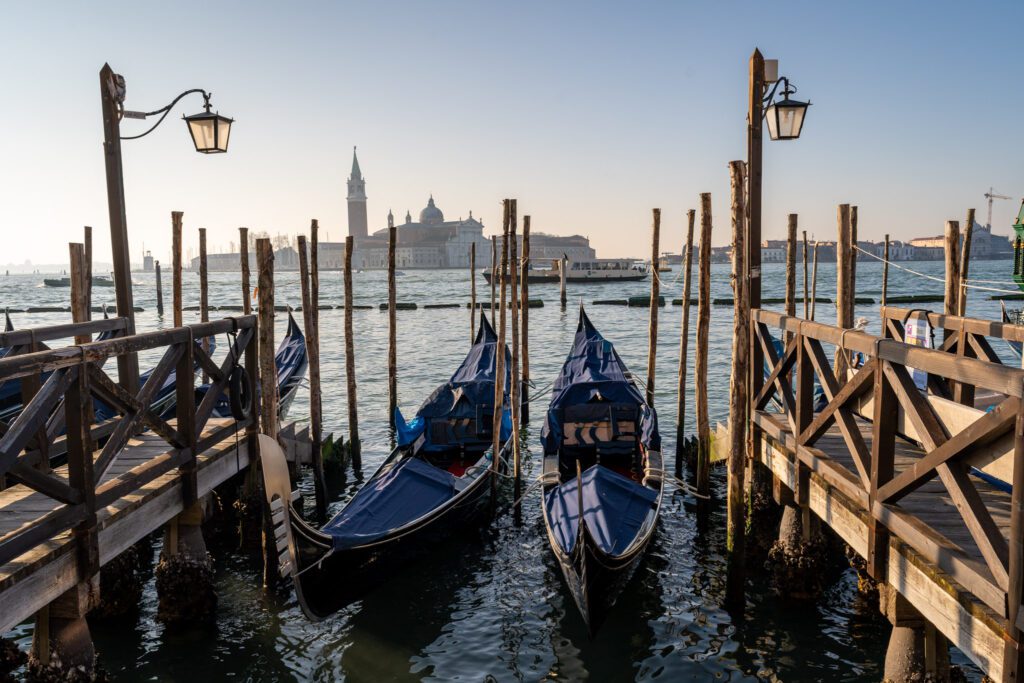
If part of your Venice vision includes a romantic gondola ride that can take you to some of the smaller canals and see parts of the city from the water that most tourists miss, then a private gondola ride is probably the better option.
I’ve had a few people ask me some version of “is a gondola ride worth it,” and while it’s a fairly personal question because it depends on what you value and your budget.
I do think it’s worth keeping in mind that Venice is one of a handful of cities in the world built around a network of canals, and seeing the city from the water is a must-do because of that.
In my opinion, the question is whether or not roughly €100 is worth it for having an experience that you’re unlikely to find anywhere else in the world.
For some, the answer is no (and I’d point you towards the vaporetto option above for a more cost-effective version). For others, the answer is yes, and that’s who this particular section is for.
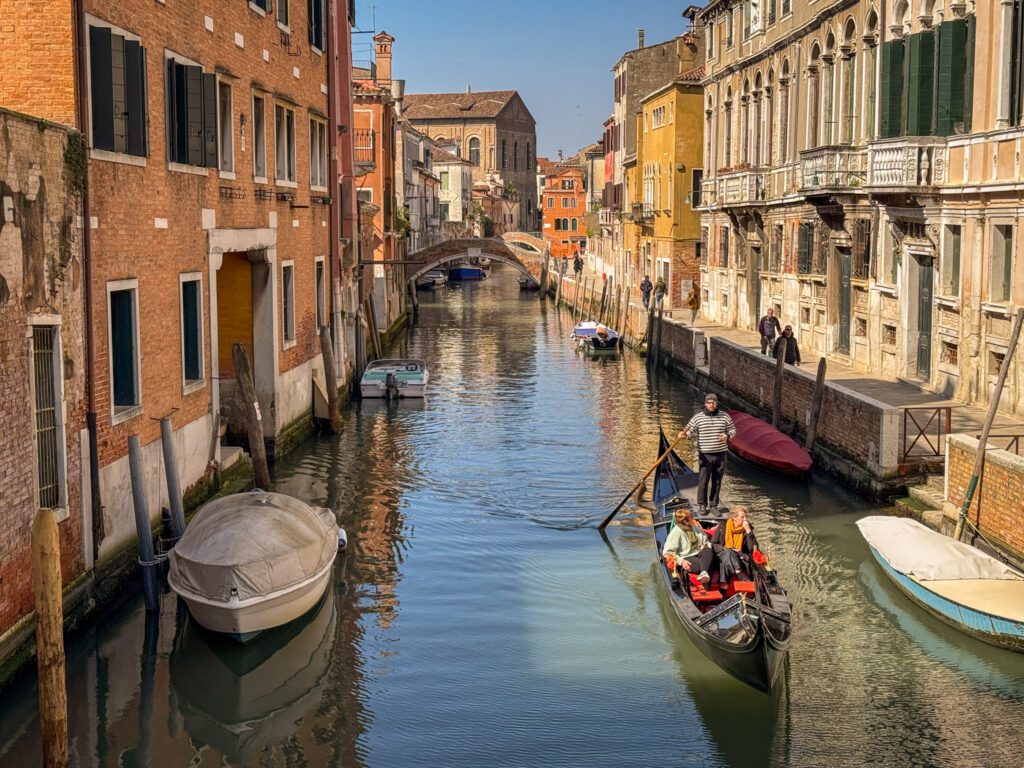
There are a few important things to know here.
First, there is no need to pre-book.
The price of a gondola ride is regulated throughout the city and, at the time of writing, a daytime gondola ride (9:00am to ~7:00pm) is set at €90 for a 30 minute ride, while an evening gondola ride is priced at €110 (for a 35 minute ride).
To book a boat, you simply find one of the many gondola stands along the city’s canals, talk to the gondoliers, go on the ride (agree to the price before you get on the boat and make sure it’s the price we just went through), and give them the fare for the ride at the end.
DO NOT PAY MORE THAN THE PRICES ABOVE. It’s a regulated price, and it is illegal to charge more for the specific durations and times of day we just covered.
Second, that price is per boat (usually a max of five people per boat), not per person, and this is going to be what you might call a “private” gondola, meaning you and your companions are the only ones in the boat (with the gondolier, of course).
Third, there is no expectation of a tip at the end of the ride. Though if you feel like you had an amazing experience, there’s also no rule that says you can’t tip your gondolier for their work.
The last thing I’d consider is where you take the gondola from. Personally, I’d avoid taking one from anywhere near Rialto Bridge or the Piazza San Marco, and instead find one in San Polo, Dorsoduro, or Cannaregio.
The reason? There are really two.
By starting in one of those less-traveled parts of the city, you’ll get to see quieter side canals that most people aren’t ever going to visit. A good example is this stand in Cannaregio.
The other reason is that you’re far more likely to have a worse experience or get scammed when you’re closer to those big tourist magnets.
Option 3: A Guided Boat Ride Through Venice
While this is certainly a more expensive option, it has a few distinct advantages that may be worth the investment, depending on your budget.
First, the vaporetto only goes on the bigger canals, while a smaller boat can take you into the maze of smaller canals that is the most special part of the city (for us).
Second, you’re connecting with both a local and like-minded travelers, which is something we try to do as often as possible.
If you don’t care so much that the boat is specifically a gondola, a shared boat ride is likely going to be a better overall experience – a better value (you might pay slightly more per person, but get ~3x the time on the water), better storytelling (to learn about Venice’s history and culture), and better camaraderie with other travelers interested in the same things as you.
Personally, this would be my choice between the two organized options (the other being the private gondola), but that should check out if you’ve spent any time at all in this corner of the internet.
Here are three options that I came across that I saved (though the timing didn’t work out on any of them for my recent trip because I was there in low season).
All of them are a 90 minute ride, and have slightly different focuses and starting points.
Keep in mind that the prices you see are for a boat ride that is three times longer than the private gondolas, which explains the price premium.
Day 2: Piazza San Marco, San Polo, and a Foodie Experience
On your second day, start at Piazza San Marco in the early morning to take it in at its most peaceful, then make your way back through the lovely district of San Polo en route to a foodie experience before ending your day in the lively neighborhood of Dorsoduro.
Piazza San Marco in the Early Morning
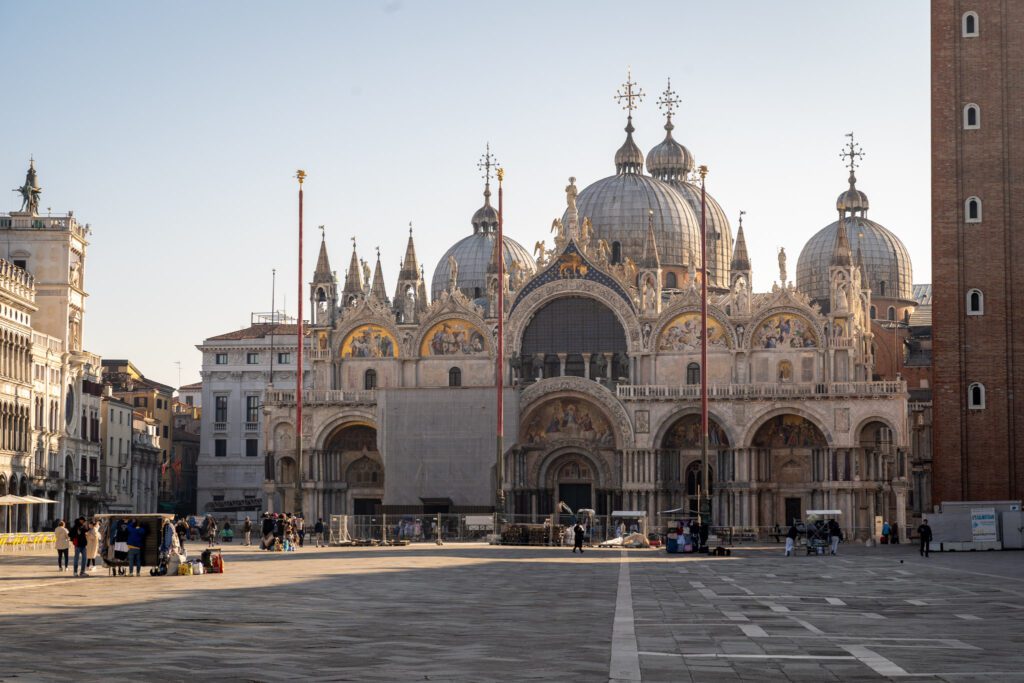
As I already mentioned in the intro to this section, my visit to Piazza San Marco at 7am was the absolute highlight of my latest trip.
To be more specific, the moment when I turned a corner from one narrow alley to another and saw the looming marble masterpiece peeking out from between the two buildings at the end of the alley literally had me uttering an audible “whoa” (though there was no one around to hear it).
At that point in my trip, I was jet lagged and my sleeping hours were all over the place, so I was already wide awake at 6am (making it easy to get out that early).
Even if you’re acclimated, I STRONGLY recommend the early wake up call so that you can see the piazza empty and have it to yourself. Then, head to get coffee and breakfast afterwards.
It will be worth it, I promise!
Spend an hour or so wandering the piazza and surrounding streets on a mini self-guided walking tour.
One thing that I think might be helpful is an audio guide of some kind to help you understand what you’re looking at.
I have done both the free Rick Steves audio guide (which is fine, but not excellent) and the paid Context audio guide (which I thought was well worth the money, and is a nice compromise between a guided tour and just showing up on your own).
Exploring San Polo (Rialto Bridge + Rialto Market)
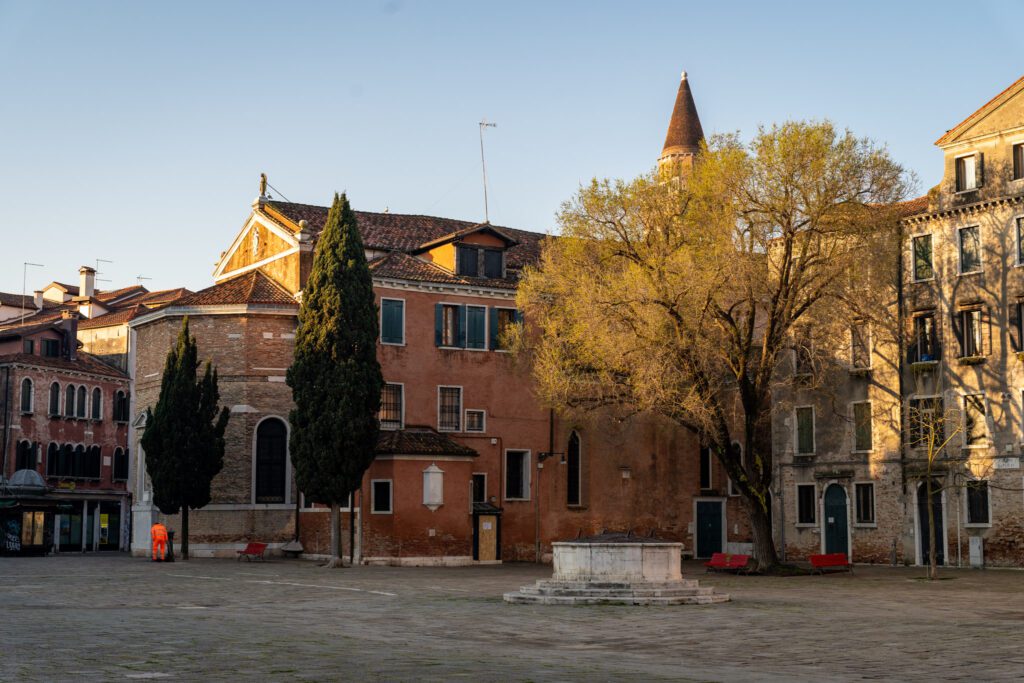
When it comes to the six sestieri of Venice, San Polo is the eye of the storm, while the other five radiate around it.
This is where I stayed, and it’s a nice mix of main sights like Rialto Bridge and Mercato Rialto, and quieter alleys and canals.
If you’re feeling fancy AND it’s 9am, you can grab a coffee at the historic Caffè Florian on Piazza San Marco, which is about as opulent an interior as you’ll find in Venice and has been a meeting place for the who’s who of Venice for centuries.
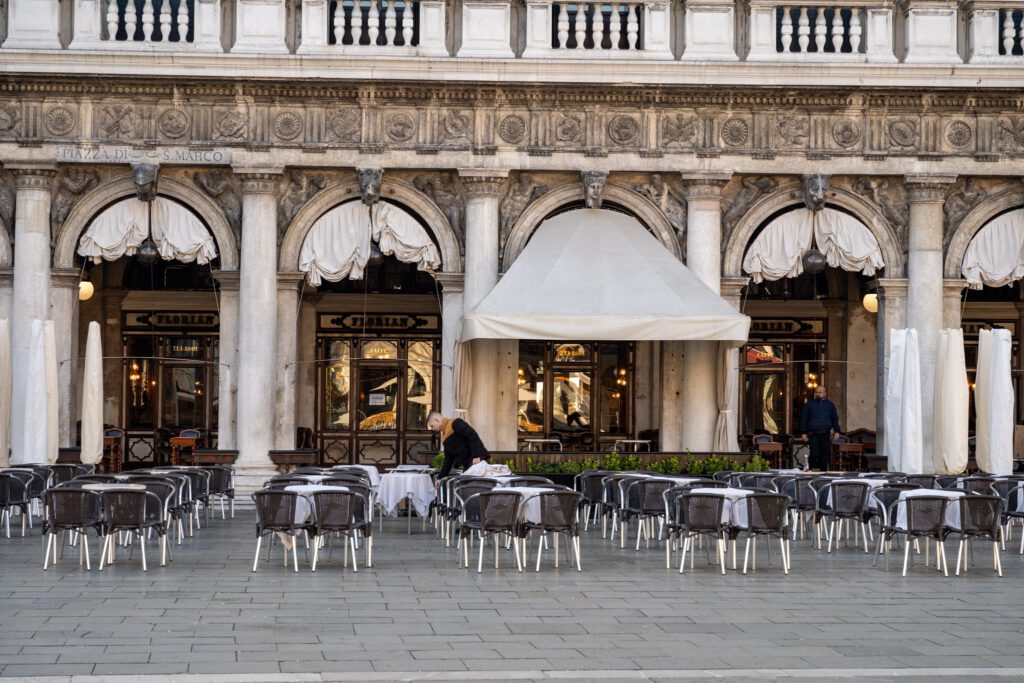
The thing you need to know is that it will also be the most expensive coffee you’ll ever drink IF you sit at a table on the square, where a hefty cover charge is added to your bill for the music on the square (which you can enjoy for free if you just hang out on the square nearby).
Instead, head inside and enjoy a coffee at the bar, which is cheaper than seated at a table AND skips that ridiculous cover charge and allows you to admire the beautiful interior.
If you’re not feeling so fancy, we have a coffee recommendation below that has better coffee at a better price with better pastries. But it’s not on the most popular square in Venice.
Anyway, whichever caffeine dealer you choose, make your way through San Marco to the world-famous Rialto Bridge.
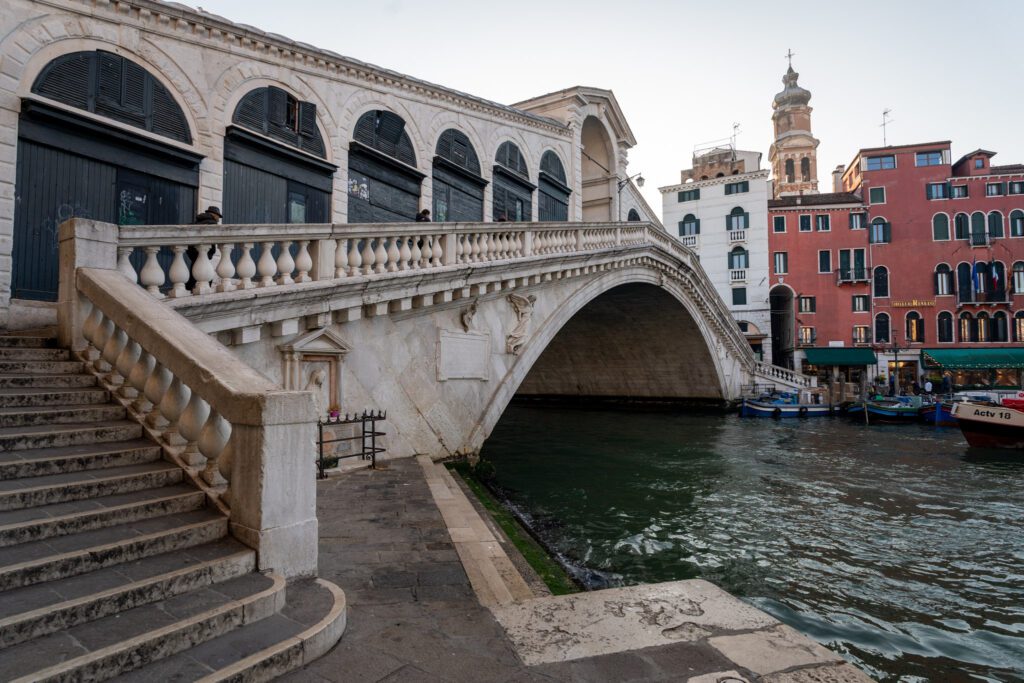
Ideally, you’re still here early enough to admire the bridge in all its glory without the hundreds of people milling around it.
This bridge is the oldest bridge in Venice that crosses over the Grand Canal (there are only four of them), and has been the center of economic activity in the city for centuries.
Originally, it was a wooden bridge, but that version of the bridge either collapsed or caught on fire several times before they decided to use stone instead, and that’s what you see here today.
There are excellent views in both directions, but we like the view down the Grand Canal to the southwest best (and it’s also the part of the bridge that gets the most packed).
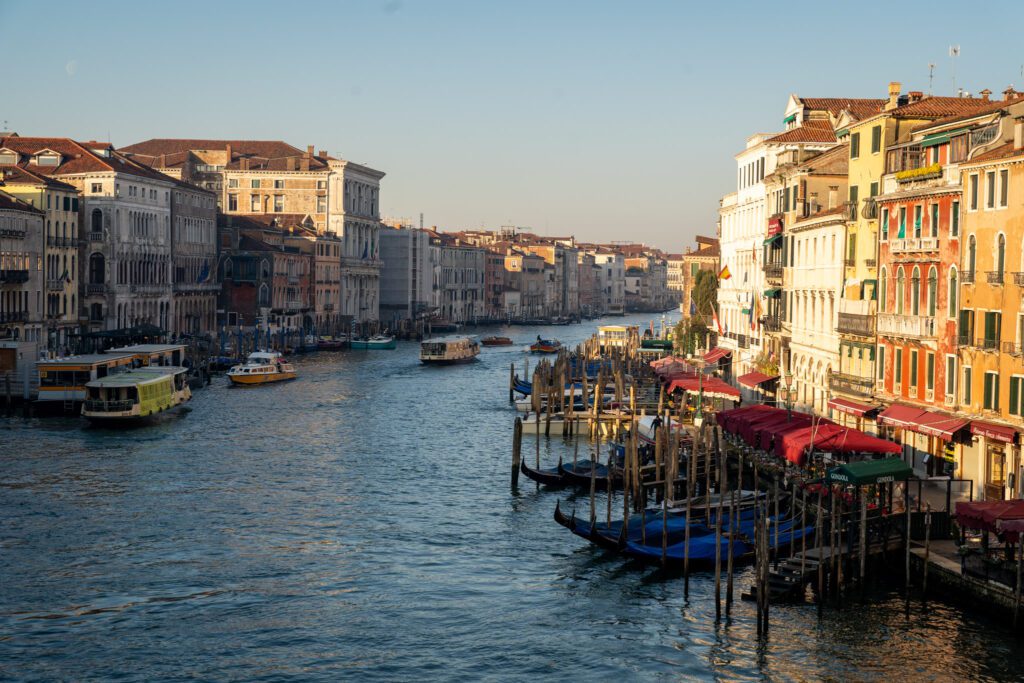
Cross the bridge from San Marco into San Polo and follow the street straight ahead, where you’ll find yourself at the Mercato di Rialto.
The open-air market (ish, it is technically covered) is full of fresh vegetables – including multiple different varieties of artichokes grown in the lagoon in the spring – and fresh fish.
It’s at its best in the morning, which is why we have you here at this particular time of day.
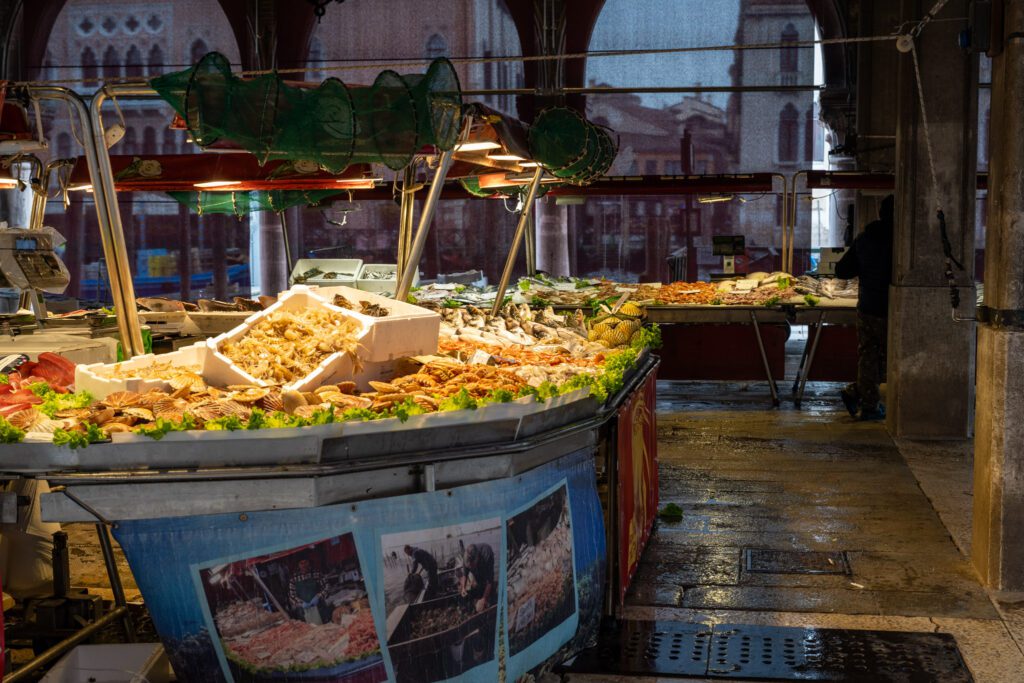
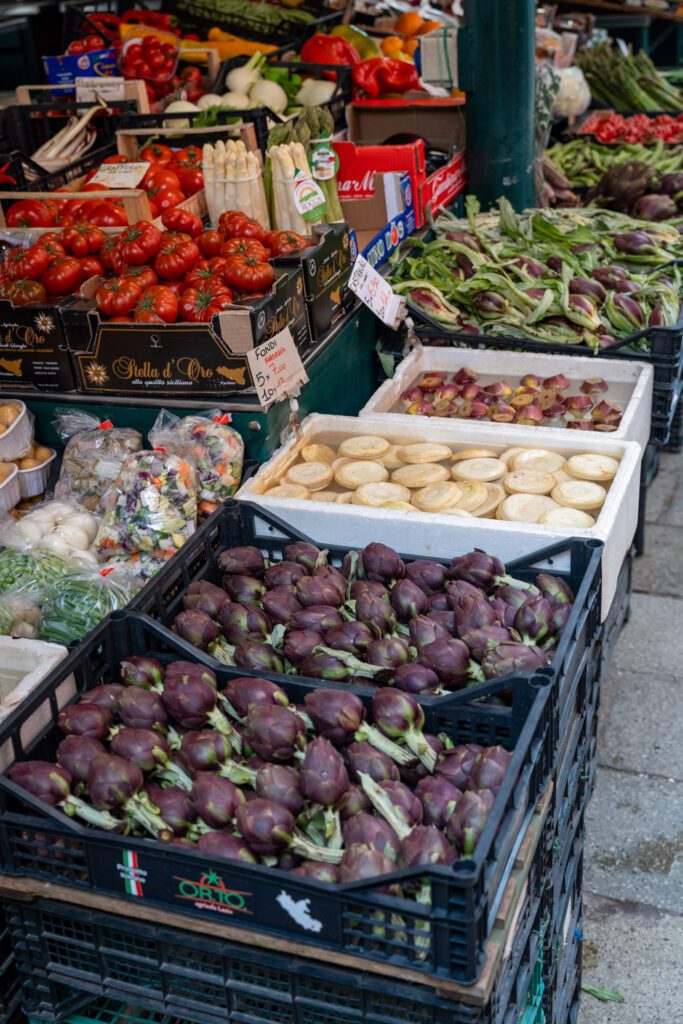
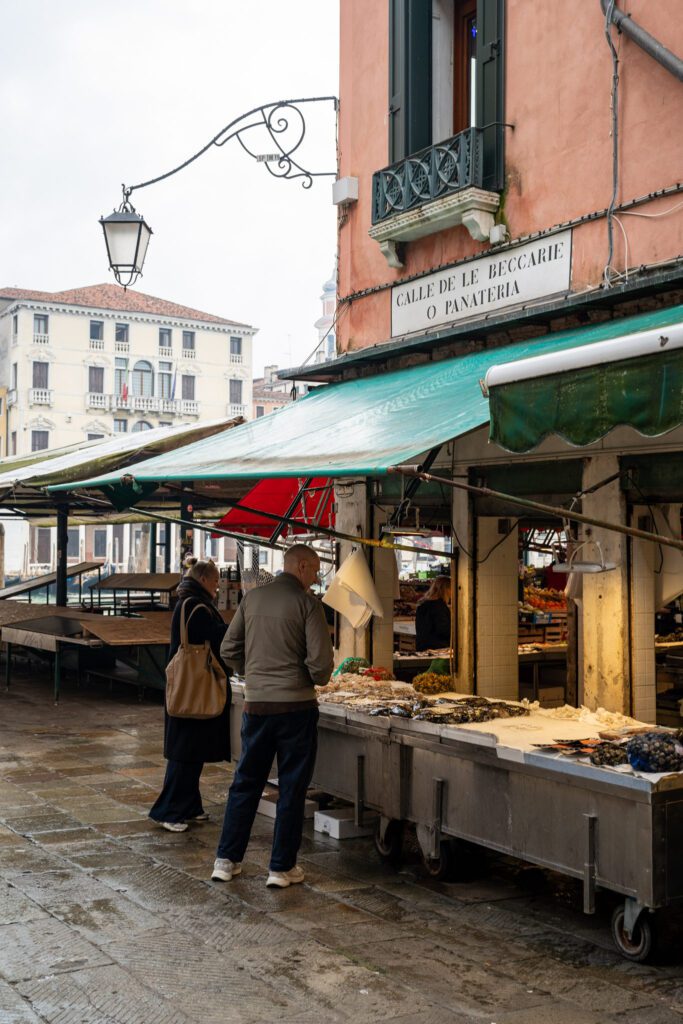
Once you’ve seen the bridge and the market, which are two of the busiest spots in the city and are teeming with visitors, we’d make your way southwest through the rest of San Polo, where you’ll find more charm and more Italian being spoken the further southwest you go.
Here are some stops we’d make sure to make along the way, and here’s a map of that route that puts together all of the stops we recommend.
- Caffè del Doge: Located on a quiet side street half a block from the Grand Canal near Rialto Bridge, this was my favorite place to grab coffee in Venice. Very friendly staff – even with my shoddy Italian – and the coffee is rich and chocolatey, which is what I’m craving when I go for espresso in Italy. Mostly locals here, which was surprising to me given the location.
- Ponte Bernardo: Of all the beautiful canal pictures I took in Venice, this was my favorite. Mostly because it’s relatively quiet, and there’s a nice view of the tower of the Frari Church down the canal to the southwest. You can find it here on Google Maps.
- Campo San Polo: One of my favorite squares in the city, lots of activity here at all times of day. In the morning, people with their dogs mill around in the center of the square. In the afternoon and evening, people walk through the square or enjoy a spritz at the tables for the restaurants on the southeastern side of the square. It’s here on Google Maps.
- Basilica di Santa Maria Gloriosa dei Frari: My second favorite church in Venice, I would say it is definitely worth the cost of entry. It’s a massive brick building that seemingly comes out of nowhere if you’re approaching it from the east, when you’ll turn a corner, cross a bridge, and BAM there’s a huge brick basilica. Some good sculptures and art on display by Donatello and Titian, and more. The structure itself is also impressive, and I really enjoyed spending 30 minutes walking through and seeing the art, tombs, and soaring ceiling.
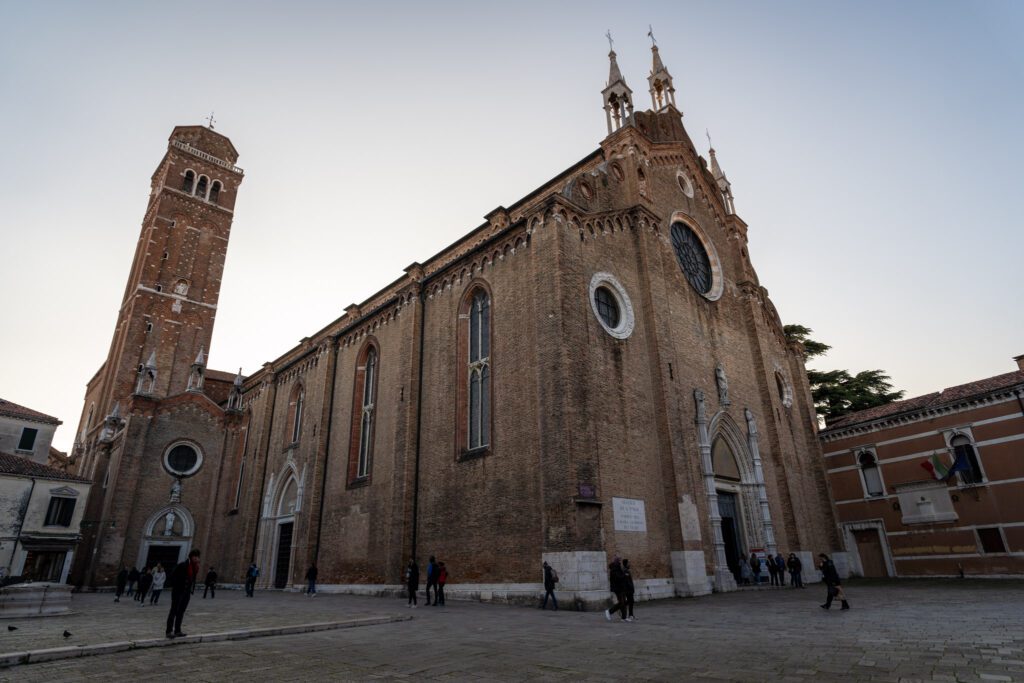
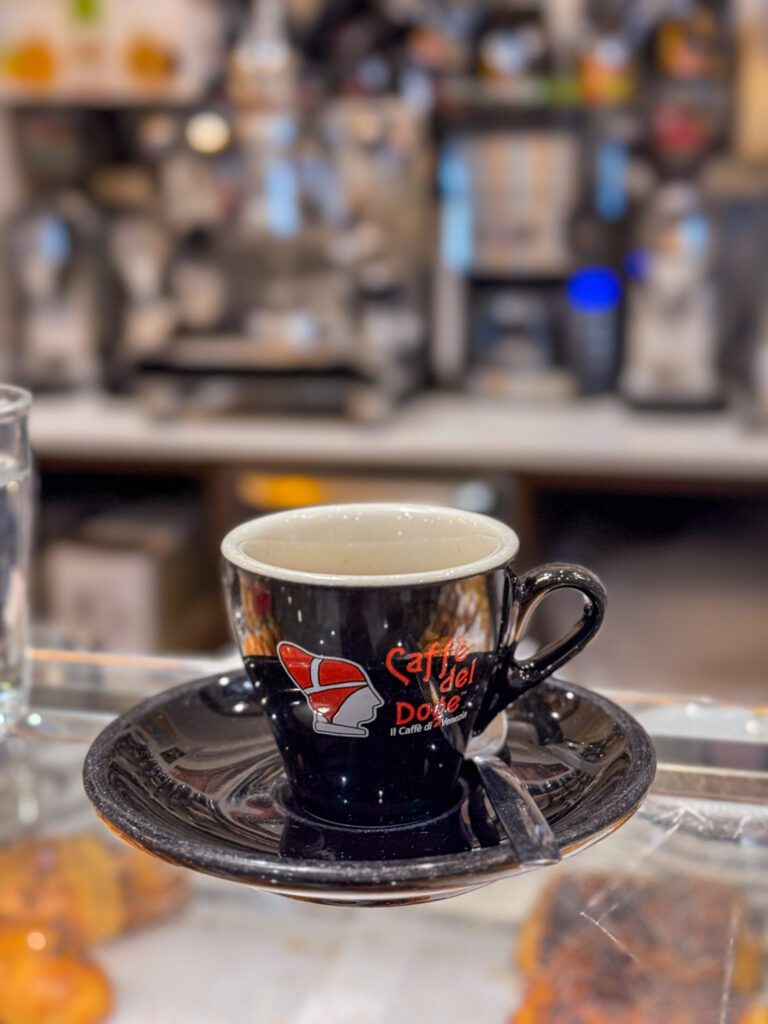
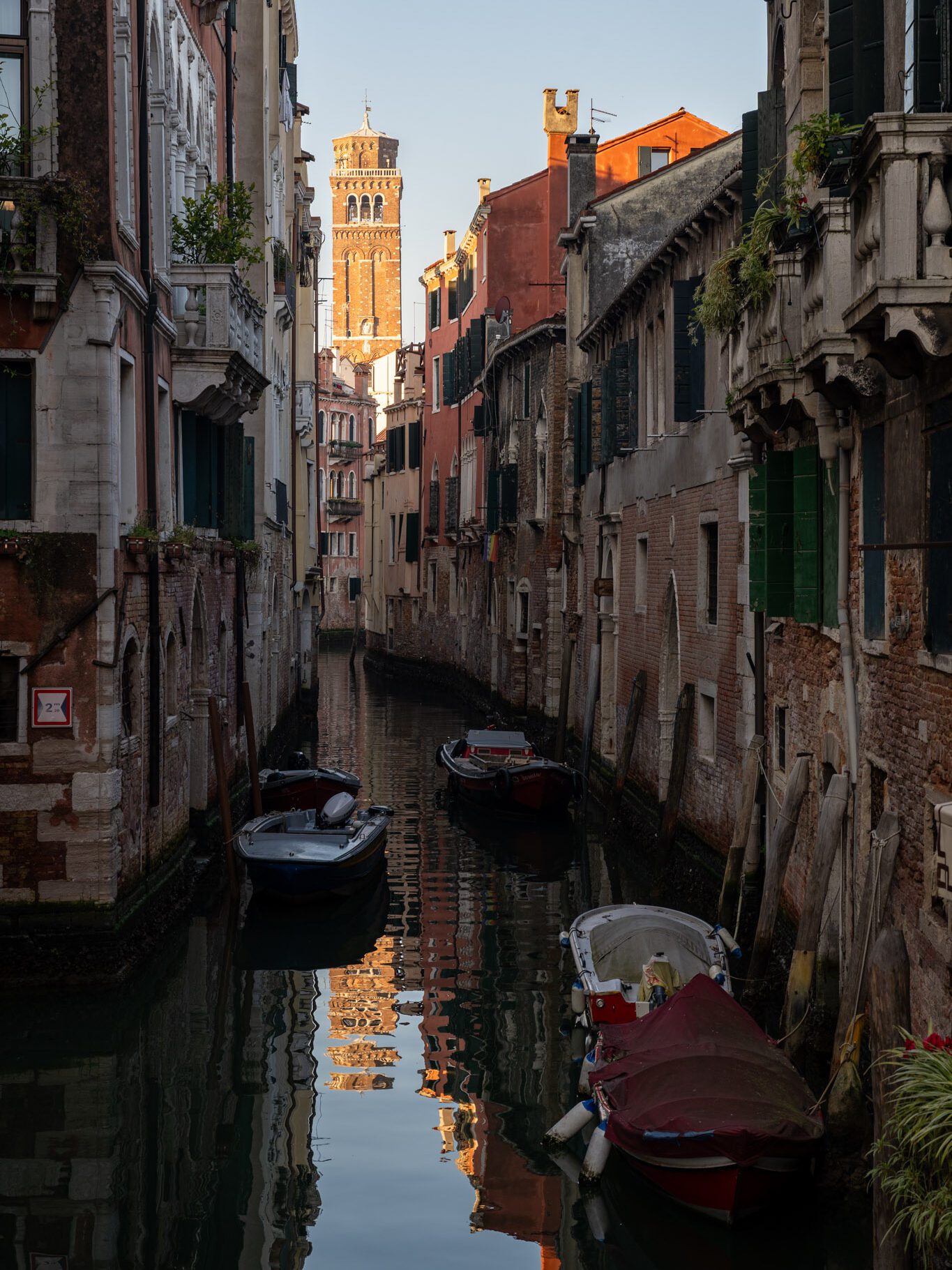
Choose Your Own Foodie Experience
Diving into the food culture in places we’re visiting is one of our favorite aspects of traveling, and we try to include a food tour, cooking class, or market tour in most places we visit.
Seeing a place through the food that they eat offers a different perspective, similar to the idea of seeing Venice from the water.
Our bias is to do a cooking class, because we LOVE to cook, but we also enjoy a good food tour.
Unfortunately, the reality is that because Matt has Celiac Disease and can’t have even a speck of gluten without being sick for days, a food tour or cooking class wasn’t in the cards for us.
HOWEVER. That does NOT mean it shouldn’t be for you!
Option 1: Take a Food Tour
We’d highly recommend a food tour because it gives you a local’s perspective on the city’s food scene – what and where to eat and drink – and you get to connect with fellow travelers and try some amazing food.
Here are some options for you that we’ve gone through and selected out of the many food tours available in Venice.
A Venetian Evening – Wine Tasting & Cicchetti: A journey through Dorsoduro, the neighborhood along the southern end of the city (where multiple guides I met in Venice live, which tells you it’s a place where people actually live, versus San Marco) and San Polo and its many bacari. A good balance between walking and eating, with plenty of wine along the way.
Venice Offbeat Food & Drinks Tour: This tour is with a company that my mom (who is not a Celiac) has done multiple food tours with around Europe and has raved about them all. The thing I like about this tour is that it covers tramezzino (a triangular sandwich specific to Venice), cicchetti, and seafood mains – all of the things I think you should try in Venice. This tour is focused on Cannaregio, which is where I was told by multiple people to focus on if you want the best food in Venice (Dorsoduro being the close second).
Venice Bacaro Tour – Eat and Drink like a Venetian: A small group is essential for an enjoyable food tour, and this tour has a max of 10 people, which is perfect. This tour is also focused on a relatively small slice of Cannaregio, and includes at least four stops along the journey. They have an afternoon and evening tour to choose from, which makes it fairly easy to fit into your itinerary.
Option 2: Get Your Hands Dirty and Take A Cooking Class
We’ve done all sorts of cooking classes around the world (read about our cooking class in Mexico City here), and while the gluten-filled nature of Italian food made it nearly impossible to do one in Venice, that doesn’t mean you shouldn’t.
Cooking classes are a fantastic way to experience the local food culture (especially if there’s a guided market tour involved), meet like-minded travelers, and add a few new recipes to your repertoire at home that will remind you of your time traveling whenever you make them.
Now, Matt has Celiac Disease, which means no gluten for us. That means that a cooking class in Italy isn’t in the cards – too much flour flying around for Matt to be comfortable and avoid getting sick.
That, however, does not mean you shouldn’t do one.
If we were doing a cooking class in Venice, our number one choice would be this cooking class with a local chef, which includes a visit to the market AND focuses on specifically Venetian recipes (versus generic pastas and lasagna, which we saw several focusing on).
The market tour, in particular, is something we always enjoy because you get so much more out of visiting a market with someone who actually knows the vendors and what the different types of produce/meat/fish are and where they come from than just wandering through alone.
Exploring Dorsoduro
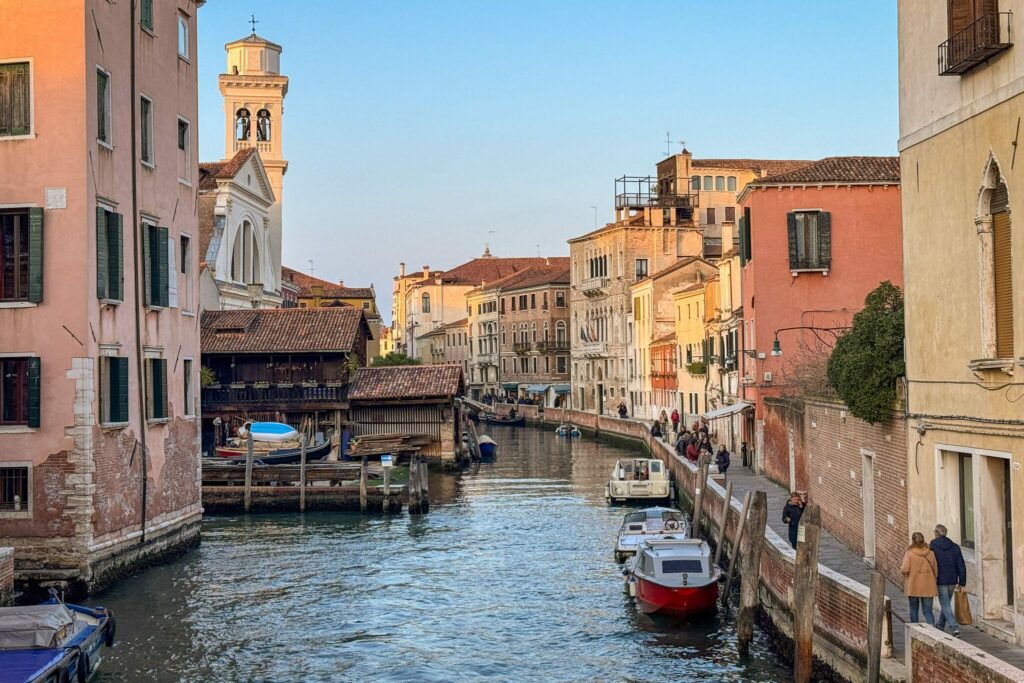
Dorsoduro, as I’ve already mentioned, is the coolest part of the city (I think).
It’s charming, lively in parts and quiet in others, and has one of the better cicchetti scenes in the city, with tons of bacari lining the side canals with people standing outside with a spritz and a cicchetti in the afternoon.
The beating heart of the neighborhood is the university – the Università Ca’ Foscari – which is at the northern edge of the neighborhood adjacent to San Polo.
If you walk through during school hours, it’s a steady stream of people who will have you questioning whether students have gotten younger, or you’re just getting older.
The connection point to San Marco – the Ponte dell’Accademia – is worth visiting in the later afternoon too.

It’s a beautiful wooden bridge that is full of people watching the boats pass underneath along the Grand Canal as the sun dips.
We’d recommend an afternoon walk through Dorsoduro that features one of the two museums and a visit to the basilica broken up by some drinks and snacks.
Which museum you opt for between the Accademia and the Peggy Guggenheim Collection depends mostly on your interests (classic art vs. modern art).
We’re going to give you some stops we’d recommend from west to east, but if you’re coming from San Marco, you can reverse the stops.
Campo Santa Margherita: A fitting place to start your journey because the liveliness here is emblematic of the rest of the neighborhood, with a significantly younger vibe than most of Venice.
There are a bunch of places to eat and drink lining the square, and on nice days the middle is full of tables of people enjoying their coffee or spritz in the sun. Find it here on Google Maps.
Campo San Barnaba: Another great campo just a short walk from the last one. I ended up here multiple times because of the fact that there’s a Grom location, which is my favorite gluten free gelato in Venice.
I like the view of the campo from the other side of the small canal right before you cross the bridge from north to south. It’s here on Google Maps.
If you want to make this your first stop for food and drinks, I walked by both Osteria Ai Pugni (here on Google Maps) and Bacaro dai Fioi (here on Google Maps), and they were two places that I saved on my map as particularly popular.
The Gallerie dell’Accademia: The best art museum in Venice if you’re interested in Venetian masters like Tintoretto and Titian and their bright colors and lifelike depictions of fabrics (I love the focus on the texture of the fabrics they are depicting).
It’s a relatively small museum as art museums in Italy go, and it will take you somewhere around two hours to see it all.
They have a nice option called “arteritivo” for people 26-35 years old that is valid Fridays from 5:15pm to 7pm, which is a nice option for this particular itinerary. No need to buy tickets in advance here.
The Collezione Peggy Guggenheim: This is a modern art museum, which are a little hit or miss for us (especially without a guide to help us interpret them). It’s very popular, and features art from famed modern art stars like Jackson Pollock, Picasso, and Dalí (among many others). You should buy tickets in advance for this one, because it’s popular and does sell out.
Rio di San Trovaso: With your museum stop complete, it’s time to eat and drink!
This particular stretch (starting here on Google Maps and running south to the end of the city) was recommended to me and I’ve seen it featured in “where to eat” guides, and it’s a great place to grab a spritz or glass of wine, a couple of cicchetti to sample, and move on to the next place that looks interesting.
The spot that always gets recommended (by food people I trust) is Osteria Al Squero, and you’ll likely see a big crowd of people out front with plastic glasses of wine and small plates piled with cicchetti.
Cantine del Vino già Schiavi is a place that I stopped for a glass of wine, and I was JEALOUS of the cicchetti that people standing next to me (there are no seats – standing room only, which is fun!) were eating.
From there, round the corner and walk along the water, which is the southern edge of the historic city.
The Basilica Santa Maria della Salute: Depending on the time of day you’re here, it might be closed to entry. But the cupola of the church here – which was built in the 16th Century to commemorate the survival of the city after a particularly bad plague – has an excellent view of the city. You’ll also find frescoes by Titian and Tintoretto in the sacristy. Entry is free, but the cupola (€8) and sacristy (€3) come with a cost. If you’re doing the museums and one of the bell towers in Venice, we’d skip it.
Here’s a map of the main stops we’ve recommended above that will give you an idea of how to piece it all together.
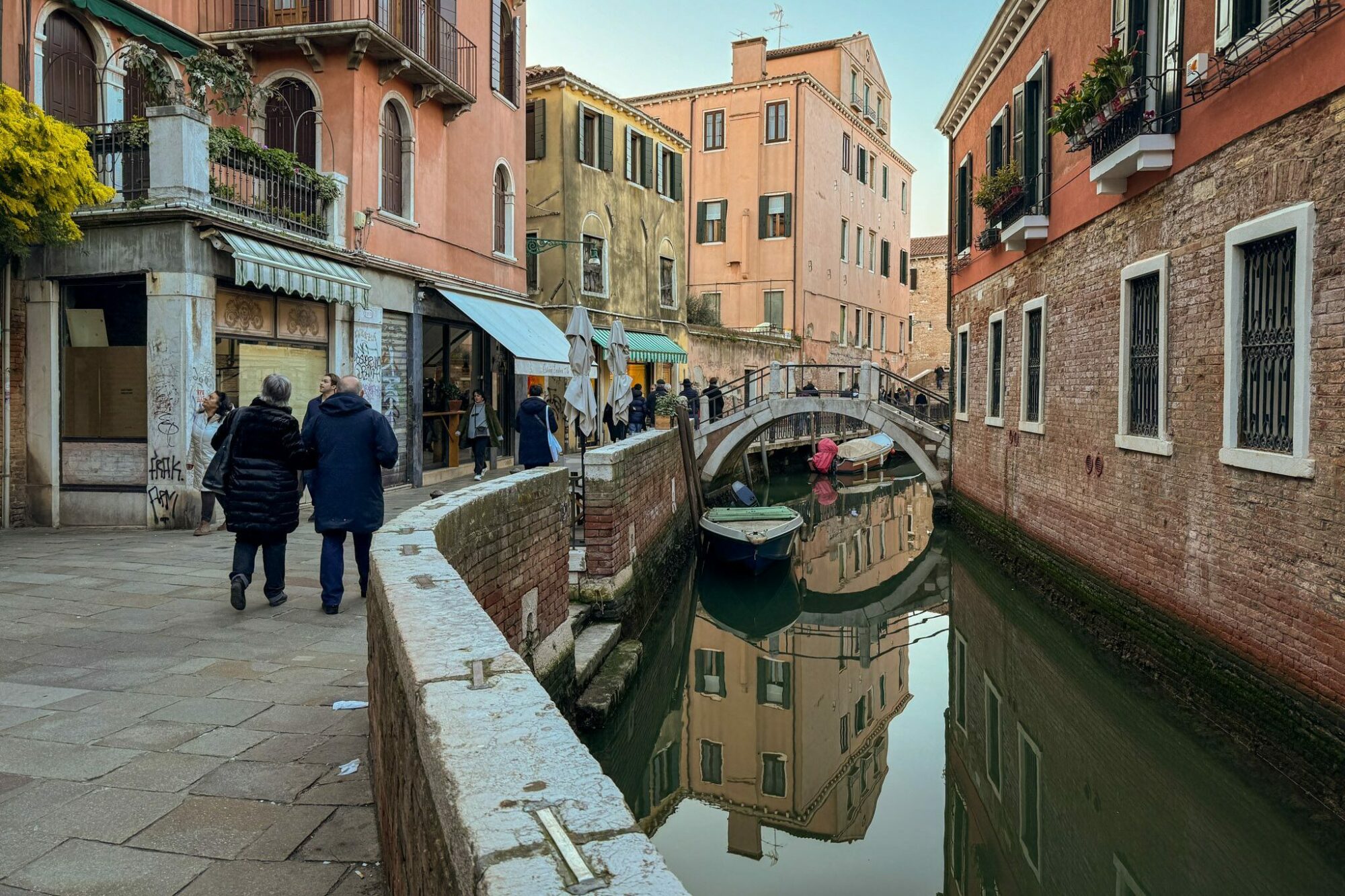
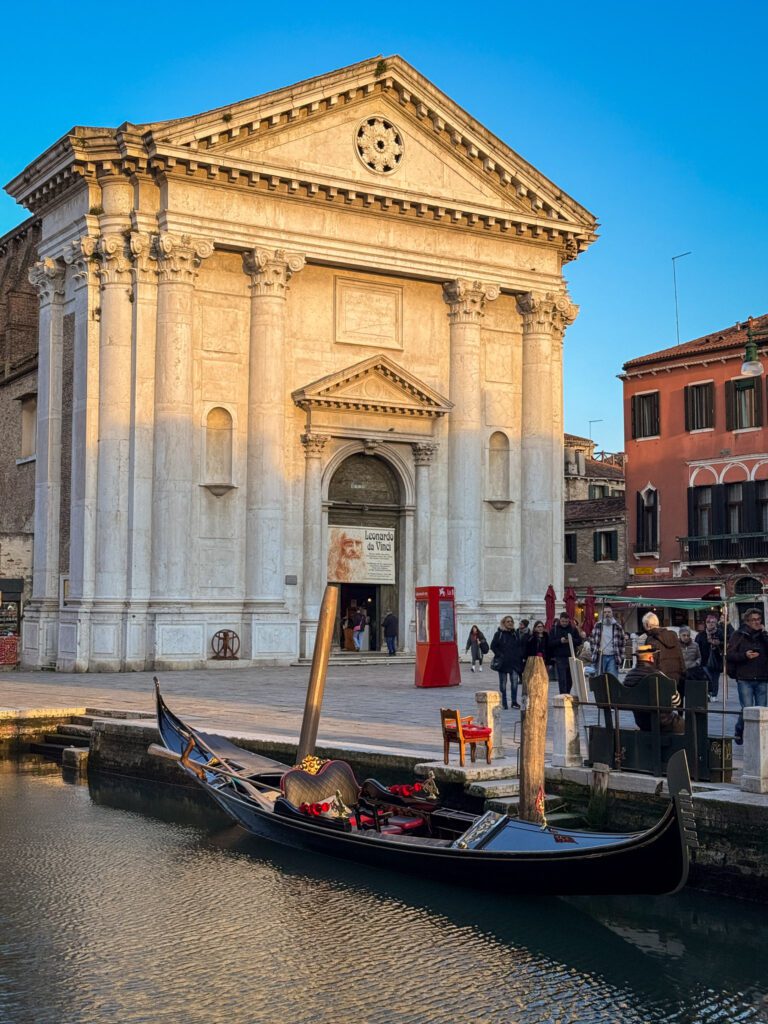
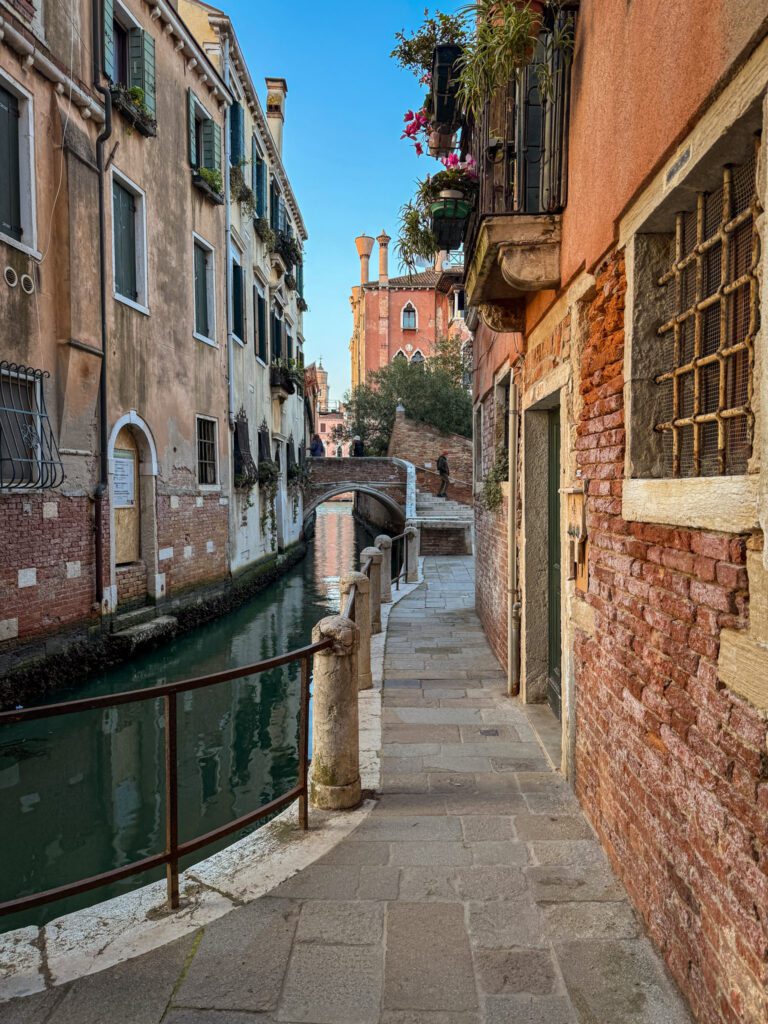
Day 3: An Island Trip and Cannaregio
On your last day in Venice, leave the main city and take the vaporetto to one of the islands nearby that are known for beautiful colorful houses and artisan workshops.
Murano, known for its glass, is the closer and more convenient option, while Burano is a longer journey, but sees far less crowds as a result and is known for its lace production.
A Trip Out to the Islands (Murano or Burano)
One of the unique aspects of the lagoon that Venice calls home is the fact that there are a bunch of small islands dotting it outside of the historic city center.
They even grow all sorts of things out on the lagoon, including artichokes and grapes, which was something I didn’t know until this latest trip in the spring in the heart of artichoke season.
Of the many options, the two islands we think you should focus on are Murano and Burano.
Murano is the closer of the two, and is also most well known and most visited.
It is known for its glass (Murano glass), and is a great place to pick up gifts to bring home and visit workshops and showrooms full of colorful pieces that are made in the lagoon.
Burano is a little further out – around 45 minutes from the vaporetto stop in Cannaregio to the island – and is known for its lace.
The higher barrier to entry in terms of time means that it sees far fewer visitors, though it is equally as beautiful as Murano.
We’d spend the morning heading out to one of the islands – choose based on your interests – and staying there through lunch.
You could, theoretically, do both, but it will take the better part of the day and you may have to move things around to fit them.
We’d say that, with three days, we’d choose one to focus on to maximize your time in Venice itself.
However, if you do absolutely have to see both, we’d head out early (like, leave Venice at 8-9am early) to beat most of the crowds out to Burano first, then hit Murano on the way back towards Venice.
The reason is that Burano is much more pleasant before the crowds arrive, and the serenity of the small island is a lot lower when it’s packed full of people.
Option 1: Murano
Murano is the significantly easier trip of the two. It takes about ten minutes to get from the vaporetto stop at Fondamente Nove (here on Google Maps) out to the stop on the southern tip of the island.
It’s also a pretty big area, with multiple smaller islands to explore including a big park at the northern end.
There are a couple of things we’d focus on for your morning out on Murano; the glass, a walk, and the two churches (more on them in a second).
Let’s start with the glass, which is the most enticing part of Murano.
Unfortunately, the reality is that the industry is not doing great, and the traditional art of glassmaking has mostly died out (especially as younger generations see the rising cost of living and realize that the math of being an artisan isn’t working).
However, there are a couple of places where you can see the artisans in action, and which you choose kind of depends on what kind of experience you’re looking for.
At the most basic level, you have the glassblowing demonstration at the Glass Cathedral, which is in a renovated church and is about as bare bones as it gets in terms of explanations and interaction with the visitors.
It’s one of the most popular (it’s right off of the vaporetto) and they have a demonstration every 45 minutes all day long, which means a lot of people come through here.
For a more in-depth and personal tour that will give you more insight into the techniques and processes they use to make Murano glass, this small group tour is a better option because it’s at a factory that sees far fewer visitors and you’ll get more explanation of what exactly you’re seeing.
Finally, if part of your vision includes actually making some glass, that same factory does a glassmaking experience that will take you even deeper and have you actually making something to take home with you.
It’s expensive, but it’s about as experiential as you can get and on par price-wise with doing a similar experience at home in the US.
The two churches are the Duomo Basilica dei Santi Maria e Donato, which is the more impressive of the two with its brick facade and gorgeous Byzantine mosaic floors (it costs €3.50 to visit, cash only), and the Chiesa di San Pietro Martire (Church of St. Peter the Martyr), which has some nice works by Tintoretto and Pablo Veronese, two of Venice’s most famous artists and is free to visit.
The Duomo is also known for (allegedly) housing the bones of the dragon slain by St. Donatus, which is…kind of funny.
They’re relatively close to each other, so if old churches with art from centuries ago are something you’re into, it’s worth visiting both.
In terms of a walk, we’d do a nice little loop that starts and ends at the vaporetto, cross over Ponte Longo Lino Toffolo to the middle island (and over to the first church, if you’re interested), and then back to the vaporetto stop. Something like this.
Option 2: Burano
If we’re being honest, we’d probably just skip Burano with limited time because, yes, the colorful houses are beautiful, but it’s also a big time investment (an hour and a half on the boat there and back) if you have a relatively short time in Venice.
However, a lot of people see the pictures of the colorful buildings and they want to see them with their own eyes. If that’s you, here’s how to make the most of it.
Burano has a lot less going on in terms of things to do (the population is less than 3,000), but is arguably more beautiful with its colorful houses and canals. You’ve almost certainly seen pictures of the photogenic colorful buildings (which some people think are in Venice itself, but are actually on an island 45 minutes away).
Burano is harder to get to – the water bus ride is closer to 45 minutes (and it stops in Murano, which is how you’d combine them if you wanted to do both) – but that also means you’ll find fewer people making the journey (though it should be noted that “fewer” does not mean that you’ll be the only visitor).
The island is in a little bit of a tough spot these days for many of the same reasons that smaller Italian towns (and American, and Canadian – it’s a universal problem) are seeing shrinking populations.
Younger generations are seeing the rising cost of living along with fewer job opportunities outside of urban centers and opting to relocate to cities like Milan rather than stay.
However, it’s also true that Burano is a little less “Disneyland-ified” than Murano, and the result is a more dynamic food scene.
Our advice here would be to take an early vaporetto, arrive, grab a coffee and a pastry for breakfast, and wander around a bit.
Eventually, you’ll want to end up at the Lace Museum (Museo del Merletto) to learn about the art of making lace, which has been a hallmark of Burano for centuries.
After that, finish circumnavigating the island, stop at Chiesa di San Martino to see the leaning bell tower, and find a place to have lunch before catching the vaporetto back to Venice for the afternoon.
Burano is, at its core, a fishing village, and you’re going to get seafood that is as fresh as it gets on the island.
If you want fresh seafood, Trattoria al Gatto Nero is a spot that was recommended to me by someone in Venice.
If you’re up for a longer walk (Burano is tiny, so you’re not going to need much time to circumnavigate it), you can extend your walk by crossing the footbridge over to Isola Mazzorbo, an island known for its vineyards (an unexpected thing to find in a lagoon).
Exploring Cannaregio
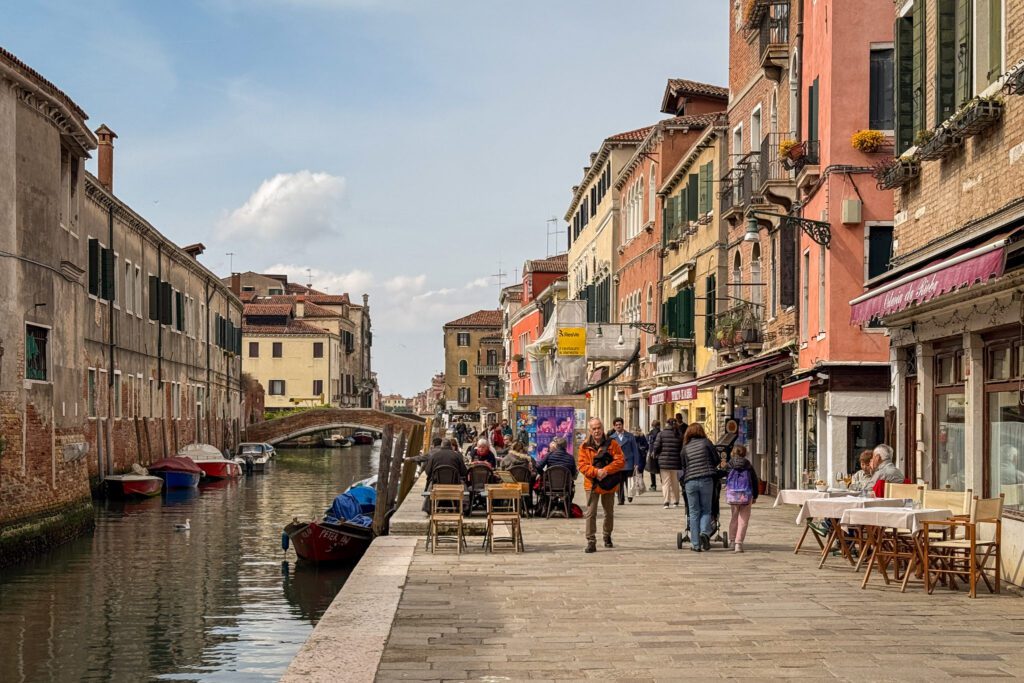
Cannaregio is the last of our three favorite neighborhoods that you’ll spend some time in on this itinerary, and we’ve potentially saved the best for last here because the further north you go (and thus the further from Piazza San Marco), the more interesting things get.
This is the part of the city where I was wandering around 2pm on a weekday and realizing that there really are multiple sides to Venice, and most visitors only get a chance to see one side on their trip.
Since you’re coming back from the islands, you’ll be arriving at Fondamente Nove, which is basically the northeast corner of the neighborhood. We’d start there and make your way southwest, ending at the train station.
Here are some stops we’d make along the way, which form a nice little promenade through Cannaregio (here’s a map linking them all together).
Basilica dei Santi Giovanni e Paolo: My third favorite church in Venice, it’s more austere than the other two, but is worth poking your head in to see the final resting place of 25 Venetian Doges and the soaring ceiling done by Veronese (along with a bunch of other beautiful art). The square it’s on is also really nice, and full of people sipping either coffee or spritzes, depending on the time of day. Very lively, very fun!
Campo Santi Apostoli: The most lively square I saw in Venice with lots of al fresco bars and restaurants, street performers, and nonnas sitting on the benches soaking up the sun.
Fondamenta de la Misericordia: My single favorite stretch of the city, this canalside walkway is full of places to eat and drink, and is a great place to have cicchetti and a spritz or three. Vino Vero was recommended to me by two different Venetians when I asked where to eat and drink in the city.
There are truly an endless number of places to eat here, and I’d follow it to Ponte de Gheto Novo (here on Google Maps), the entry point to one of the three former Jewish ghettos in Venice.
The Gheto Novo: Similar to many places in Europe, at one point, Venice has a complicated, less-than-savory history when it comes to its Jewish inhabitants.
At one point, they were welcomed. Then they were forced to live in specific areas (there are three former Jewish ghettos in Venice, all in this general vicinity, and they are the oldest in the world) and then they were expelled completely to the mainland as the Catholic Church began to flex its muscles and exert power over Venice.
It’s a sad story, and if that’s something you’re interested in learning about I highly recommend Lucia’s walking tour focused on Jewish history in Venice, which I did and loved.
Otherwise, walk through the area to the other entry gate (here on Google Maps), which was one of the main gates to enter the ghetto, stopping at the Museo Ebraico di Venezia (closed for renovations when I was there) for a guided tour and a lesson in Venice’s Jewish history and a visit to the synagogue upstairs.
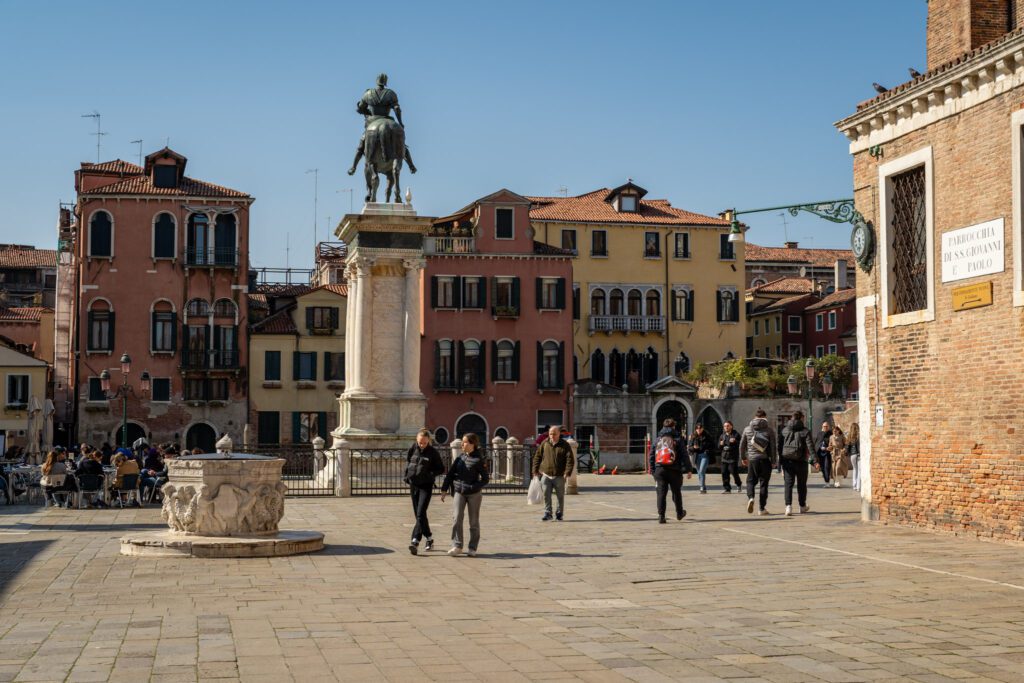
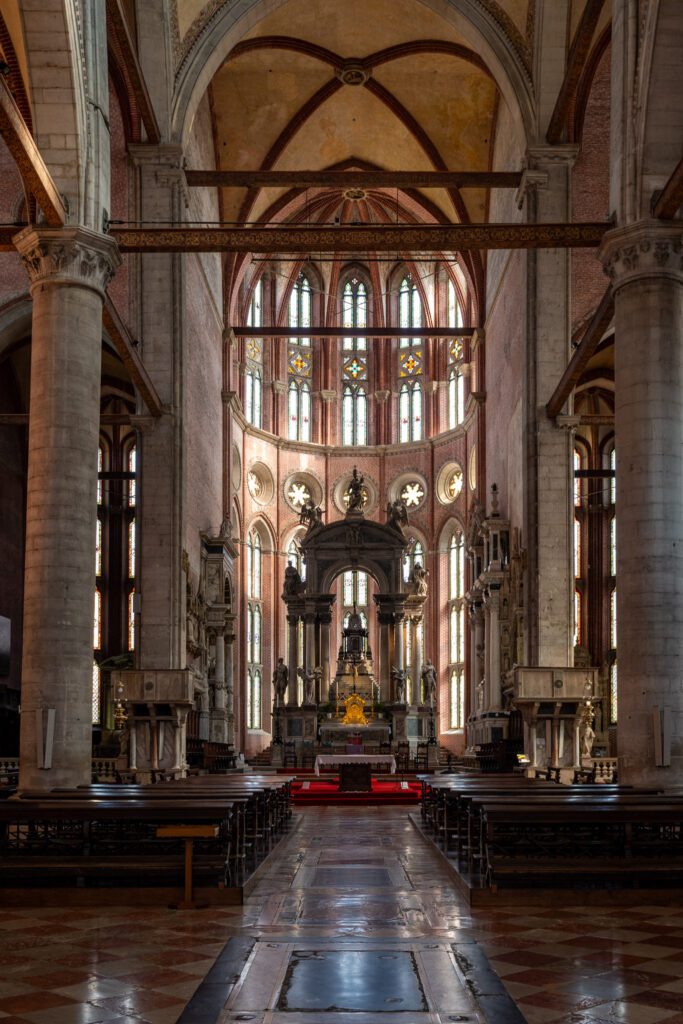
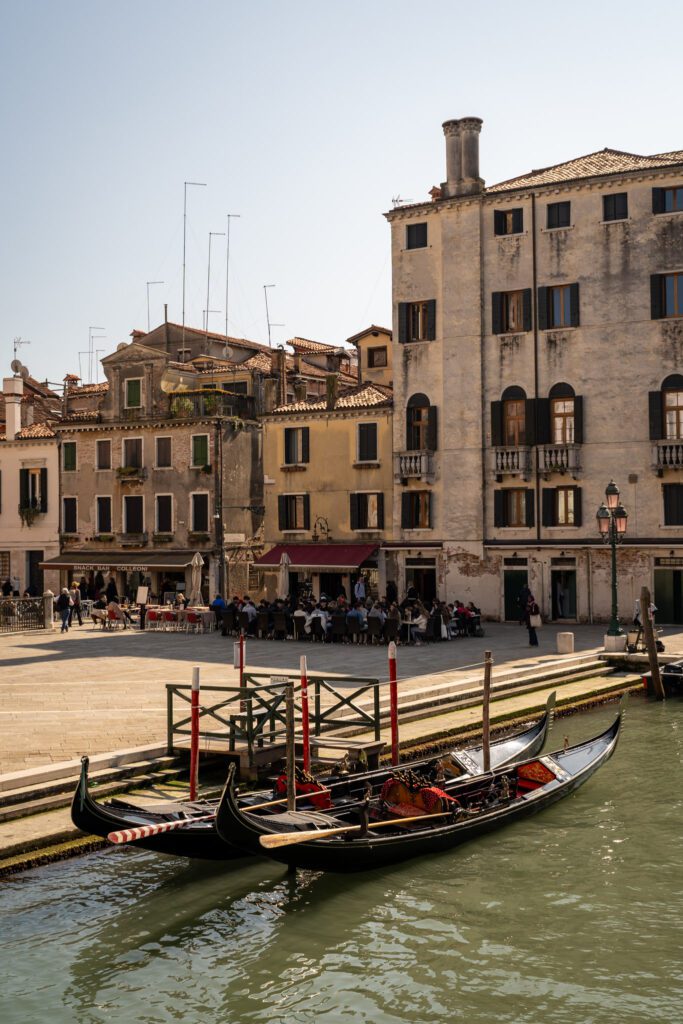
What to Do with More Time in Venice
Here are a few things to add if you find yourself with more time in Venice.
Head out to San Giorgio Maggiore (+2 Hours)
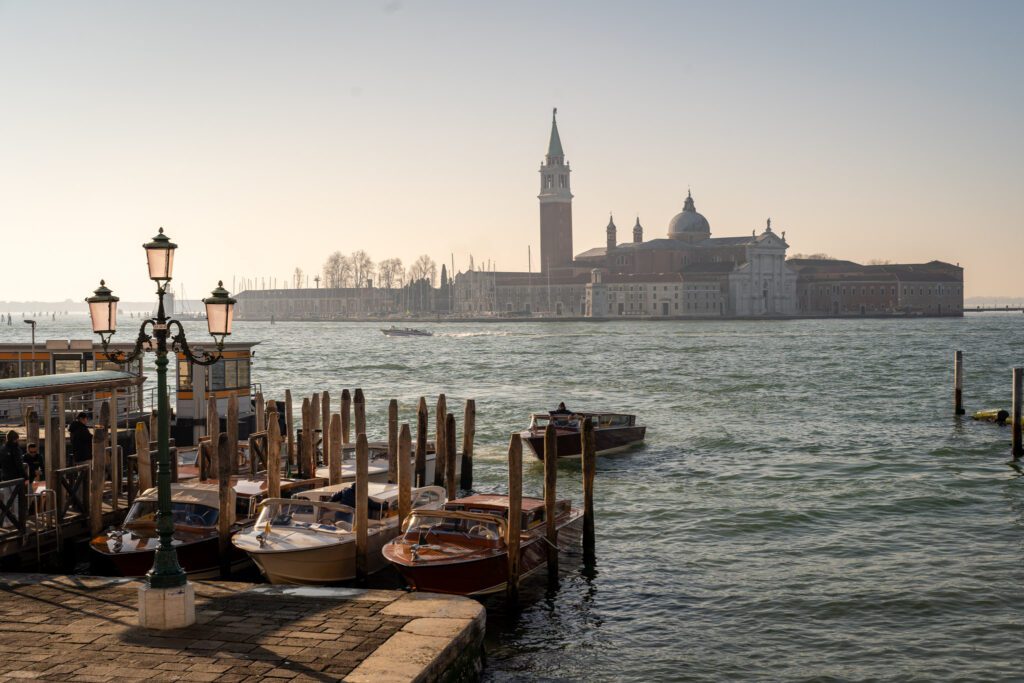
I didn’t get a chance to do this myself, but the view from the bell tower at San Giorgio Maggiore – an abbey out in the middle of the lagoon that you’ll have to take a boat to – is supposed to be one of the greatest views of the city.
To get there, you can take the 2 from the Grand Canal just east of Piazza San Marco, and it’s a quick, one stop ride to the island. It’s free to enter the church, but it costs €8 to get up to the bell tower for the view (there’s an elevator).
Add Another Island – Murano / Burano / Torcello (+½ Day)
As we said in the island section in the main itinerary, three days is not a particularly long stay in Venice, and we’d opt to spend as much time in Venice itself as you can, rather than spending a full day exploring the islands north of the city.
If you find yourself with more time, then it makes sense to add another island, maybe even two (Torcello has the oldest church in Venice and sees far fewer tourists than the other two – it’s a significant vibe shift with more greenery).
If you’re going to do them all in one day, we’d do it in this order; Burano, Torcello, Murano.
Day Trip to Verona (+1 Day)

If you have an extra day, Verona is a beautiful riverfront city that we absolutely love (as long as you skip Juliet’s House, which is the worst tourist attraction we’ve ever personally done).
There’s a huge Roman arena, several excellent viewpoints, a couple of nice churches, and a museum or two that are worth your time. Overall, a very enjoyable place, and we ended up spending three days there a few years ago.
Best of all, it’s a quick and easy hour and fifteen minute high speed train ride from Venice (book in advance for cheaper fares).
More on what to do and see in our guide to spending a day in Verona.
What to Do with Less Time in Venice
With two days, we’d completely cut the islands and essentially follow the first two days of the itinerary above mostly as written (you could try to squeeze in both Cannaregio and Dorsoduro over the course of those two days).
If you have just a day dedicated to exploring Venice, we want to reiterate that we highly recommend making sure you have an overnight in Venice (rather than doing it as a day trip) in order to see the city at its best in the early morning and evening.
With one day, you’re likely going to have the afternoon/evening of the first day and the morning of the second.
We’d basically split your time in half, spending the first half on Piazza San Marco (do the basilica and the Doge’s Palace) and then spend the second half riding the Vaporetto and either doing a walking tour or self-guided version that covers the Jewish ghetto, Rialto Market, and a church or two.
Planning a trip to Italy? We’d love to help!
Here are our other Italy travel guides to help you plan an incredible trip (even if you have to eat gluten free!).
If there’s no link below, it means we’re still working on it – long, in-depth guides take time! We’re working on it, though, we promise.
If you’re planning a trip and you’re not sure where to start, your first stop should probably be one of our detailed itineraries.
We have a two week Italy itinerary that blends the main cities with some less-visited cities that we love (BOLOGNA!), a guide to spending 10 days in Italy that focuses mostly on the highlights, and a whirlwind guide to spending one week in Italy that features the Rome – Florence – Venice highlight circuit.
We also have a guide covering important tips for traveling to Italy for the first time, which is a collection of things we’ve learned over the course of our time in Italy that will help you have a smoother, more immersive trip.
Here are more specific guides to the main cities in Italy.
Rome
- What to do in Rome (as a First Timer)
- How to Plan an Amazing 4 Day Rome Itinerary
- Where to Stay in Rome: A Complete Guide for First Timers
- 26 Things to Know Before You Visit Rome
- Gluten Free Rome: A Complete Guide to GF Restaurants + Bakeries
- Where to Find the Best Specialty Coffee in Rome
Florence
- What to do in Florence (as a First Timer)
- How to Plan an Amazing Florence Itinerary (3 Days)
- Where to Stay in Florence: A Complete Guide for First Timers
- Gluten Free Florence: A Complete Guide to GF Restaurants + Bakeries
- Where to Find the Best Specialty Coffee in Florence (for Coffee Nerds)
- The Best Day Trips from Florence (Complete Planning Guide)
Venice
- A Perfect 3 Day Venice Itinerary (for First Timers)
- Exactly What to Do in Venice (As a First Timer)
- Where to Stay in Venice: A Complete Guide
- Gluten Free Venice: A Complete Guide (for Foodies)
Bologna
- What to do in Bologna (as a First Timer)
- How to Spend One Incredible Day in Bologna
- How to Plan an Amazing Bologna Itinerary (2 Days)
- Where to Stay in Bologna: A Complete Guide for First Timers
Cinque Terre
- What to do in Cinque Terre (as a First Timer)
- How to Plan an Amazing Cinque Terre Itinerary (2 Days)
- Where to Stay in Cinque Terre: A Complete Guide for First Timers
Milan
- What to do in Milan (as a First Timer)
- How to Plan an Amazing Milan Itinerary (2 Days)
- Where to Stay in Milan: A Complete Guide for First Timers
- Gluten Free Milan: A Complete Guide to GF Restaurants + Bakeries
The Rest of Italy
